Solar and Wind Energy Integrated System Frequency Control: A Critical Review on Recent Developments
Abstract
1. Introduction
2. General Description of Solar PV, Wind System, and Frequency Control
2.1. Solar PV and Wind Integrated System
2.2. Frequency Control Issues
3. Frequency Control with Auxiliary Devices
3.1. Wind System Frequency Control
3.1.1. SMES Control System
3.1.2. FACTS Devices
3.1.3. Supercapacitor
3.1.4. Electric Vehicle, Batteries, and other Devices
3.2. Solar Based System
3.2.1. Battery Storage System
3.2.2. Flywheel Energy Storage
3.2.3. Superconducting and other Storage Devices
4. Frequency Control without Auxiliary Devices
4.1. Wind-Based System
4.1.1. De-Loading Technique
4.1.2. Inertial Response Technique
4.1.3. Droop Control System
4.1.4. Other Techniques
4.2. Solar-Based System
4.2.1. Inertial Response Technique
4.2.2. De-Loading Technique
4.2.3. Grid-Forming Control Techniques
4.2.4. Artificial Neural Network
4.2.5. Fuzzy Logic Technique
4.2.6. Particle Swarm Optimization and Genetic Algorithm
4.2.7. Other Soft Computing Approaches
4.2.8. Industry Trends in Frequency Control
5. Challenges and Opportunities
- Hybridization, sizing, and locations of energy storage devices need further research to improve the frequency stability of renewable energy integrated systems.
- Frequency control in a microgrid is still a challenging task due to its small-scale nature. Such systems should consider both frequency protection and control issues together with auxiliary devices.
- Accurate system modeling is required for the successful implementation of advanced control systems. The stochastic behavior of renewable energy sources should be taken into account in new and improved models to further improve frequency stability. Model complexity should be minimized as much as possible in order to make it easier to put these models into practice in the actual world.
- Advanced control approaches (such as adaptive, intelligent, resilient, optimum, and hierarchical control) can improve the integration of high-level RES while reducing frequency stability.
- The impacts of the lifetime of energy storage devices should be investigated in frequency control.
- Low inertia is a major challenge when integrating RES. Virtual inertia and droop controllers have helped to tackle this challenge, but the performance of such controllers can be improved with a better design approach. Advanced techniques can optimize virtual inertia for high RES systems, which can then be supported by enhanced virtual controllers.
- It is necessary to investigate further what kind of storage systems (either high power density or high energy density) should be employed in low-inertia grids in order to reap the most significant benefits.
- The de-loading techniques have been utilized for the solar PV and wind systems. However, the calculation of the de-loading margin is still an open question.
- The batteries of the EVs can support the frequency of the system. However, determining the optimal assistance from an EV’s battery can be challenging due to a variety of factors, including car charging and discharging times, unforeseen vehicle arrival and departure from parking spaces, and others. More research efforts should be put in this direction, considering high-level EVs’ penetration in the next few years.
- The renewable energy integration capacity and energy storage devices sizing should be optimized together for the best frequency response.
- The RESs integrated system frequency control is adversely affected by the application of various types of loads. However, the simulation of linear loads alone is routinely used to validate research findings. With non-linear loads, which are hardly ever used in the literature, such as dynamic loads, inductive motor loads, and constant power loads, there are possibilities to test the frequency response. Future studies should reassess the use of these types of loads with the experimental setup.
6. Conclusions
Author Contributions
Funding
Data Availability Statement
Conflicts of Interest
References
- Fernández-Guillamón, A.; Gómez-Lázaro, E.; Muljadi, E.; Molina-García, Á. Power systems with high renewable energy sources: A review of inertia and frequency control strategies over time. Renew. Sustain. Energy Rev. 2019, 115, 109369. [Google Scholar] [CrossRef]
- Martínez-Álvarez, F.; Schmutz, A.; Asencio-Cortés, G.; Jacques, J. A novel hybrid algorithm to forecast functional time series based on pattern sequence similarity with application to electricity demand. Energies 2019, 12, 94. [Google Scholar] [CrossRef]
- Liu, Z.; Sun, Y.; Xing, C.; Liu, J.; He, Y.; Zhou, Y.; Zhang, G. Artificial intelligence powered large-scale renewable integrations in multi-energy systems for carbon neutrality transition: Challenges and future perspectives. Energy AI 2022, 10, 100195. [Google Scholar] [CrossRef]
- Wråke, M.; Breen, K.; Burnard, K.; Cheung, K. Energy Technology Perspectives 2012; OECD Publishing: Paris, France, 2012. [Google Scholar]
- Alam, M.S.; Abido, M.A.Y. Fault ride through capability enhancement of a large-scale PMSG wind system with bridge type fault current limiters. Adv. Electr. Comput. Eng. 2018, 18, 43–50. [Google Scholar] [CrossRef]
- Rahman, S.M.; Al-Ismail, F.S.M.; Haque, M.E.; Shafiullah, M.; Islam, M.R.; Chowdhury, M.T.; Alam, M.S.; Razzak, S.A.; Ali, A.; Khan, Z.A. Electricity generation in Saudi Arabia: Tracing opportunities and challenges to reducing greenhouse gas emissions. IEEE Access 2021, 9, 116163–116182. [Google Scholar] [CrossRef]
- D’hulst, R.; Fernandez, J.M.; Rikos, E.; Kolodziej, D.; Heussen, K.; Geibelk, D.; Temiz, A.; Caerts, C. Voltage and frequency control for future power systems: The ELECTRA IRP proposal. In Proceedings of the 2015 International Symposium on Smart Electric Distribution Systems and Technologies (EDST), Vienna, Austria, 7–11 September 2015; pp. 245–250. [Google Scholar]
- Hadjipaschalis, I.; Poullikkas, A.; Efthimiou, V. Overview of current and future energy storage technologies for electric power applications. Renew. Sustain. Energy Rev. 2009, 13, 1513–1522. [Google Scholar] [CrossRef]
- Morren, J.; De Haan, S.W.; Kling, W.L.; Ferreira, J. Wind turbines emulating inertia and supporting primary frequency control. IEEE Trans. Power Syst. 2006, 21, 433–434. [Google Scholar] [CrossRef]
- Fini, M.H.; Golshan, M.E.H. Frequency control using loads and generators capacity in power systems with a high penetration of renewables. Electr. Power Syst. Res. 2019, 166, 43–51. [Google Scholar] [CrossRef]
- Ulbig, A.; Borsche, T.S.; Andersson, G. Impact of low rotational inertia on power system stability and operation. IFAC Proc. Vol. 2014, 47, 7290–7297. [Google Scholar] [CrossRef]
- Alam, M.S.; Chowdhury, M.S.H.; Uddin, M.A. Power system switching transient detection using wavelet transformed based signal decomposition. IIUC Stud. 2010, 7, 241–248. [Google Scholar] [CrossRef]
- Energy, S.P. Technology Roadmap. Technical Report, IEA, September 2014. Available online: https://www.iea.org/reports/technology-roadmap-energy-storage (accessed on 29 December 2022).
- Nghiem, A.; Pineda, I. Wind Energy in Europe: Scenarios for 2030. WindEurope: Brussels, Belgium. 2017. Available online: https://windeurope.org/wp-content/uploads/files/about-wind/reports/Wind-energy-in-Europe-Scenarios-for-20 (accessed on 29 December 2022).
- Daly, P.; Flynn, D.; Cunniffe, N. Inertia considerations within unit commitment and economic dispatch for systems with high non-synchronous penetrations. In Proceedings of the 2015 IEEE Eindhoven PowerTech, Eindhoven, The Netherlands, 29 June–2 July 2015; pp. 1–6. [Google Scholar]
- Jahan, E.; Hazari, M.R.; Muyeen, S.; Umemura, A.; Takahashi, R.; Tamura, J. Primary frequency regulation of the hybrid power system by deloaded PMSG-based offshore wind farm using centralised droop controller. J. Eng. 2019, 2019, 4950–4954. [Google Scholar] [CrossRef]
- Amrouche, S.O.; Rekioua, D.; Rekioua, T.; Bacha, S. Overview of energy storage in renewable energy systems. Int. J. Hydrog. Energy 2016, 41, 20914–20927. [Google Scholar] [CrossRef]
- Khooban, M.H.; Niknam, T. A new intelligent online fuzzy tuning approach for multi-area load frequency control: Self Adaptive Modified Bat Algorithm. Int. J. Electr. Power Energy Syst. 2015, 71, 254–261. [Google Scholar] [CrossRef]
- Magdy, G.; Mohamed, E.A.; Shabib, G.; Elbaset, A.A.; Mitani, Y. SMES based a new PID controller for frequency stability of a real hybrid power system considering high wind power penetration. IET Renew. Power Gener. 2018, 12, 1304–1313. [Google Scholar] [CrossRef]
- Yang, L.; Hu, Z.; Xie, S.; Kong, S.; Lin, W. Adjustable virtual inertia control of supercapacitors in PV-based AC microgrid cluster. Electr. Power Syst. Res. 2019, 173, 71–85. [Google Scholar] [CrossRef]
- Magdy, G.; Shabib, G.; Elbaset, A.A.; Mitani, Y. A novel coordination scheme of virtual inertia control and digital protection for microgrid dynamic security considering high renewable energy penetration. IET Renew. Power Gener. 2019, 13, 462–474. [Google Scholar] [CrossRef]
- Khalid, J.; Ramli, M.A.; Khan, M.S.; Hidayat, T. Efficient Load Frequency Control of Renewable Integrated Power System: A Twin Delayed DDPG-Based Deep Reinforcement Learning Approach. IEEE Access 2022, 10, 51561–51574. [Google Scholar] [CrossRef]
- Adaryani, M.R.; Taher, S.A.; Guerrero, J.M. Improved direct model predictive control for variable magnitude variable frequency wave energy converter connected to constant power load. J. Energy Storage 2021, 43, 103175. [Google Scholar] [CrossRef]
- Liu, J.; Yao, Q.; Hu, Y. Model predictive control for load frequency of hybrid power system with wind power and thermal power. Energy 2019, 172, 555–565. [Google Scholar] [CrossRef]
- Kumar, N.K.; Gopi, R.S.; Kuppusamy, R.; Nikolovski, S.; Teekaraman, Y.; Vairavasundaram, I.; Venkateswarulu, S. Fuzzy Logic-Based Load Frequency Control in an Island Hybrid Power System Model Using Artificial Bee Colony Optimization. Energies 2022, 15, 2199. [Google Scholar] [CrossRef]
- Prasad, S.; Purwar, S.; Kishor, N. Load frequency regulation using observer based non-linear sliding mode control. Int. J. Electr. Power Energy Syst. 2019, 104, 178–193. [Google Scholar] [CrossRef]
- Pillai, A.G.; Samuel, E.R.; Unnikrishnan, A. Optimal load frequency control through combined state and control gain estimation for noisy measurements. Prot. Control. Mod. Power Syst. 2020, 5, 1–12. [Google Scholar] [CrossRef]
- Elsisi, M.; Soliman, M.; Aboelela, M.; Mansour, W. Bat inspired algorithm based optimal design of model predictive load frequency control. Int. J. Electr. Power Energy Syst. 2016, 83, 426–433. [Google Scholar] [CrossRef]
- Alam, M.; Almehizia, A.A.; Al-Ismail, F.S.; Hossain, M.; Islam, M.A.; Shafiullah, M.; Ullah, A. Frequency Stabilization of AC Microgrid Clusters: An Efficient Fractional Order Supercapacitor Controller Approach. Energies 2022, 15, 5179. [Google Scholar] [CrossRef]
- Komijani, A.; Sedighizadeh, M.; Kheradmandi, M. Improving Fault Ride-Through in meshed microgrids with wind and PV by Virtual Synchronous Generator with SFCL and SMES. Journal of Energy Storage 2022, 50, 103952. [Google Scholar] [CrossRef]
- Mishra, D.K.; Złotecka, D.; Li, L. Significance of SMES Devices for Power System Frequency Regulation Scheme considering Distributed Energy Resources in a Deregulated Environment. Energies 2022, 15, 1766. [Google Scholar] [CrossRef]
- Amin, M.R.; Negnevitsky, M.; Franklin, E.; Alam, K.S.; Naderi, S.B. Application of battery energy storage systems for primary frequency control in power systems with high renewable energy penetration. Energies 2021, 14, 1379. [Google Scholar] [CrossRef]
- Suvire, G.O.; Ontiveros, L.J.; Mercado, P.E. Combined control of a flywheel energy storage system and a vanadium redox flow battery for wind energy applications in microgrids. Dyna 2017, 84, 230–238. [Google Scholar] [CrossRef]
- Alam, M.S.; Al-Ismail, F.S.; Abido, M.A. Power management and state of charge restoration of direct current microgrid with improved voltage-shifting controller. J. Energy Storage 2021, 44, 103253. [Google Scholar] [CrossRef]
- Zdiri, M.A.; Guesmi, T.; Alshammari, B.M.; Alqunun, K.; Almalaq, A.; Salem, F.B.; Hadj Abdallah, H.; Toumi, A. Design and Analysis of Sliding-Mode Artificial Neural Network Control Strategy for Hybrid PV-Battery-Supercapacitor System. Energies 2022, 15, 4099. [Google Scholar] [CrossRef]
- Mohamed, M.M.; El Zoghby, H.M.; Sharaf, S.M.; Mosa, M.A. Optimal virtual synchronous generator control of battery/supercapacitor hybrid energy storage system for frequency response enhancement of photovoltaic/diesel microgrid. J. Energy Storage 2022, 51, 104317. [Google Scholar] [CrossRef]
- Kalyan, C.N.S.; Goud, B.S.; Reddy, C.R.; Bajaj, M.; Sharma, N.K.; Alhelou, H.H.; Siano, P.; Kamel, S. Comparative Performance Assessment of Different Energy Storage Devices in Combined LFC and AVR Analysis of Multi-Area Power System. Energies 2022, 15, 629. [Google Scholar] [CrossRef]
- Yang, R.H.; Jin, J.X.; Zhou, Q.; Xiao, M. Non-droop-control-based cascaded superconducting magnetic energy storage/battery hybrid energy storage system. Journal of Energy Storage 2022, 54, 105309. [Google Scholar] [CrossRef]
- Bizon, N. Effective mitigation of the load pulses by controlling the battery/SMES hybrid energy storage system. Appl. Energy 2018, 229, 459–473. [Google Scholar] [CrossRef]
- Chicco, G.; Schlabbach, J.; Spertino, F. Experimental assessment of the waveform distortion in grid-connected photovoltaic installations. Sol. Energy 2009, 83, 1026–1039. [Google Scholar] [CrossRef]
- Alam, M.S.; Abido, M.A.Y.; Hussein, A.E.D.; El-Amin, I. Fault ride through capability augmentation of a DFIG-based wind integrated VSC-HVDC system with non-superconducting fault current limiter. Sustainability 2019, 11, 1232. [Google Scholar] [CrossRef]
- Calleja, H.; Jimenez, H. Performance of a grid connected PV system used as active filter. Energy Convers. Manag. 2004, 45, 2417–2428. [Google Scholar] [CrossRef]
- Prodanović, M.; De Brabandere, K.; Van den Keybus, J.; Green, T.; Driesen, J. Harmonic and reactive power compensation as ancillary services in inverter-based distributed generation. IET Gener. Transm. Distrib. 2007, 1, 432–438. [Google Scholar] [CrossRef]
- Fadaeinedjad, R.; Moschopoulos, G.; Moallem, M. The impact of tower shadow, yaw error, and wind shears on power quality in a wind–diesel system. IEEE Trans. Energy Convers. 2009, 24, 102–111. [Google Scholar] [CrossRef]
- Magesh, T.; Devi, G.; Lakshmanan, T. Measurement and simulation of power quality issues in grid connected wind farms. Electr. Power Syst. Res. 2022, 210, 108142. [Google Scholar] [CrossRef]
- Shafiul Alam, M.; Abido, M.A.Y. Fault ride-through capability enhancement of voltage source converter-high voltage direct current systems with bridge type fault current limiters. Energies 2017, 10, 1898. [Google Scholar] [CrossRef]
- Alsharif, H.; Jalili, M.; Hasan, K.N. Power system frequency stability using optimal sizing and placement of Battery Energy Storage System under uncertainty. J. Energy Storage 2022, 50, 104610. [Google Scholar] [CrossRef]
- Rashid, M.M.U.; Alotaibi, M.A.; Chowdhury, A.H.; Rahman, M.; Alam, M.S.; Hossain, M.A.; Abido, M.A. Home energy management for community microgrids using optimal power sharing algorithm. Energies 2021, 14, 1060. [Google Scholar] [CrossRef]
- Gupta, S.K.; Ghose, T.; Chatterjee, K. Coordinated control of Incentive-Based Demand Response Program and BESS for frequency regulation in low inertia isolated grid. Electric Power Systems Research 2022, 209, 108037. [Google Scholar] [CrossRef]
- Chown, G.; Wright, J.G.; Van Heerden, R.P.; Coker, M. System inertia and Rate of Change of Frequency (RoCoF) with increasing non-synchronous renewable energy penetration. In Proceedings of the 8th CIGRE Southern Africa Regional Conference, Cape Town, South Africa, 14–17 November 2017. [Google Scholar]
- Shazon, M.N.H.; Jawad, A. Frequency control challenges and potential countermeasures in future low-inertia power systems: A review. Energy Rep. 2022, 8, 6191–6219. [Google Scholar] [CrossRef]
- Jorgenson, J.L.; Denholm, P.L. Modeling Primary Frequency Response for Grid Studies; Technical Report; National Renewable Energy Lab. (NREL): Golden, CO, USA, 2019. [Google Scholar]
- Chen, Z. Compensation schemes for a SCR converter in variable speed wind power systems. IEEE Trans. Power Deliv. 2004, 19, 813–821. [Google Scholar] [CrossRef]
- Salman, S.K.; Teo, A.L. Windmill modeling consideration and factors influencing the stability of a grid-connected wind power-based embedded generator. IEEE Trans. Power Syst. 2003, 18, 793–802. [Google Scholar] [CrossRef]
- Pappachen, A.; Fathima, A.P. Load frequency control in deregulated power system integrated with SMES–TCPS combination using ANFIS controller. Int. J. Electr. Power Energy Syst. 2016, 82, 519–534. [Google Scholar] [CrossRef]
- Ali, M.H.; Wu, B.; Dougal, R.A. An overview of SMES applications in power and energy systems. IEEE Trans. Sustain. Energy 2010, 1, 38–47. [Google Scholar] [CrossRef]
- Tripathy, S.; Balasubramanian, R.; Nair, P. Effect of superconducting magnetic energy storage on automatic generation control considering governor deadband and boiler dynamics. IEEE Trans. Power Syst. 1992, 7, 1266–1273. [Google Scholar] [CrossRef]
- Westlake, A.; Bumby, J.; Spooner, E. Damping the power-angle oscillations of a permanent-magnet synchronous generator with particular reference to wind turbine applications. IEE Proc. Electr. Power Appl. 1996, 143, 269–280. [Google Scholar] [CrossRef]
- Dondapati, R.S.; Kumar, A.; Kumar, G.R.; Usurumarti, P.R.; Dondapati, S. Superconducting magnetic energy storage (SMES) devices integrated with resistive type superconducting fault current limiter (SFCL) for fast recovery time. J. Energy Storage 2017, 13, 287–295. [Google Scholar] [CrossRef]
- Mohamed, E.A.; Ahmed, E.M.; Elmelegi, A.; Aly, M.; Elbaksawi, O.; Mohamed, A.A.A. An optimized hybrid fractional order controller for frequency regulation in multi-area power systems. IEEE Access 2020, 8, 213899–213915. [Google Scholar] [CrossRef]
- Elmelegi, A.; Mohamed, E.A.; Aly, M.; Ahmed, E.M.; Mohamed, A.A.A.; Elbaksawi, O. Optimized tilt fractional order cooperative controllers for preserving frequency stability in renewable energy-based power systems. IEEE Access 2021, 9, 8261–8277. [Google Scholar] [CrossRef]
- Elshiekh, M.; Elwakeel, A.; Venuturumilli, S.; Alafnan, H.; Pei, X.; Zhang, M.; Yuan, W. Utilising SMES-FCL to improve the transient behaviour of a doubly fed induction generator DC wind system. Int. J. Electr. Power Energy Syst. 2021, 131, 107099. [Google Scholar] [CrossRef]
- Alam, M.S.; Abido, M.A.Y.; El-Amin, I. Fault current limiters in power systems: A comprehensive review. Energies 2018, 11, 1025. [Google Scholar] [CrossRef]
- Alam, M.S.; AL-Ismail, F.S.; Abido, M.; Hossain, M.A. Fault current limiter of VSC-HVDC systems using variable resistive bridge controller. Ain Shams Eng. J. 2021, 12, 2643–2654. [Google Scholar] [CrossRef]
- Alam, M.S.; Alotaibi, M.A.; Alam, M.A.; Hossain, M.A.; Shafiullah, M.; Al-Ismail, F.S.; Rashid, M.M.U.; Abido, M.A. High-level renewable energy integrated system frequency control with SMES-based optimized fractional order controller. Electronics 2021, 10, 511. [Google Scholar] [CrossRef]
- Abdelbadie, H.T.; Taha, A.T.; Hasanien, H.M.; Turky, R.A.; Muyeen, S. Stability Enhancement of Wind Energy Conversion Systems Based on Optimal Superconducting Magnetic Energy Storage Systems Using the Archimedes Optimization Algorithm. Processes 2022, 10, 366. [Google Scholar] [CrossRef]
- Salama, H.S.; Vokony, I.; Zobair, M.; Aly, M.M. Amelioration the Stability of Power System Coupled with SCIG and PMSG Using Controlled-SMES. In Proceedings of the 2020 International Conference on Innovative Trends in Communication and Computer Engineering (ITCE), Aswan, Egypt, 8–9 February 2020; pp. 346–351. [Google Scholar]
- Jin, J.X.; Yang, R.H.; Zhang, R.T.; Fan, Y.J.; Xie, Q.; Chen, X.Y. Combined low voltage ride through and power smoothing control for DFIG/PMSG hybrid wind energy conversion system employing a SMES-based AC-DC unified power quality conditioner. Int. J. Electr. Power Energy Syst. 2021, 128, 106733. [Google Scholar] [CrossRef]
- Qais, M.H.; Hasanien, H.M.; Alghuwainem, S. Output power smoothing of wind power plants using self-tuned controlled SMES units. Electr. Power Syst. Res. 2020, 178, 106056. [Google Scholar] [CrossRef]
- Hartmann, B.; Lipták, S. Development of steady state and dynamic energy storage models for DIgSILENT PowerFactory. In Proceedings of the 2015 IEEE Eindhoven PowerTech, Eindhoven, The Netherlands, 29 June–2 July 2015; pp. 1–6. [Google Scholar]
- Noori, A.; Shahbazadeh, M.J.; Eslami, M. Designing of wide-area damping controller for stability improvement in a large-scale power system in presence of wind farms and SMES compensator. Int. J. Electr. Power Energy Syst. 2020, 119, 105936. [Google Scholar] [CrossRef]
- Alam, M.S.; Al-Ismail, F.S.; Abido, M.A. PV/wind-integrated low-inertia system frequency control: PSO-optimized fractional-order PI-based SMES approach. Sustainability 2021, 13, 7622. [Google Scholar] [CrossRef]
- Mihalic, R.; Zunko, P.; Papic, I.; Povh, D. Improvement of transient stability by insertion of FACTS devices. In Proceedings of the Joint International Power Conference Athens Power Tech, Athens, Greece, 5–8 September 1993; Volume 2, pp. 521–525. [Google Scholar]
- Clark, K.; Fardanesh, B.; Adapa, R. Thyristor controlled series compensation application study-control interaction considerations. IEEE Trans. Power Deliv. 1995, 10, 1031–1037. [Google Scholar] [CrossRef]
- Hingorani, N.G. Flexible AC transmission. IEEE Spectr. 1993, 30, 40–45. [Google Scholar] [CrossRef]
- Gyugyi, L. A unified flow control concept for flexible AC transmission systems. In Proceedings of the International Conference on AC and DC Power Transmission, London, UK, 17–20 September 1991; pp. 19–26. [Google Scholar]
- Gyugyi, L.; Schauder, C.; Williams, S.; Rietman, T.; Torgerson, D.; Edris, A. The unified power flow controller: A new approach to power transmission control. IEEE Trans. Power Deliv. 1995, 10, 1085–1097. [Google Scholar] [CrossRef]
- Gyugyi, L. Unified power-flow control concept for flexible AC transmission systems. IEE Proc. C (Gener. Transm. Distrib.) 1992, 139, 323–331. [Google Scholar] [CrossRef]
- Sahu, R.K.; Gorripotu, T.S.; Panda, S. A hybrid DE-PS algorithm for load frequency control under deregulated power system with UPFC and RFB. Ain Shams Eng. J. 2015, 6, 893–911. [Google Scholar] [CrossRef]
- Hussein, A.A.; Hasan, N.; Nasirudin, I.; Farooq, S. Load frequency controller for multisource interconnected nonlinear power system incorporating FACTs devices. Int. J. Autom. Control 2020, 14, 257–283. [Google Scholar] [CrossRef]
- Alam, M.S.; Razzak, A.; Islam, N.; Hossain, F.S. Transient Stability Enhancement Of Bangladesh East West Interconnected System Using Static VAR Compensator (SVC). Int. J. Eng. Res. Technol 2013, 2, 730–733. [Google Scholar]
- Lastomo, D.; Setiadi, H.; Djalal, M.R. Enabling PID and SSSC for load frequency control using Particle Swarm Optimization. In Proceedings of the 2017 3rd International Conference on Science in Information Technology (ICSITech), Bandung, Indonesia, 25–26 October 2017; pp. 182–187. [Google Scholar]
- Shankar, R. Grey Wolf Algorithm based Control Strategy for Load Frequency Control in Coordination with IPFC. In Proceedings of the 2018 International Conference on Recent Innovations in Electrical, Electronics & Communication Engineering (ICRIEECE), Bhubaneswar, India, 27–28 July 2018; pp. 569–574. [Google Scholar]
- Salgotra, A.; Pan, S. A frequency domain model-based design of PSS and TCSC controller for damping the small signal oscillations in the power system. Int. Trans. Electr. Energy Syst. 2019, 29, e2742. [Google Scholar] [CrossRef]
- Alam, M.S.; Razzak, M.A.; Hasan, M.N.; Chowdhury, A.H. Transmission capacity enhancement of East-West Interconnectors using series-shunt compensation. In Proceedings of the 2012 7th International Conference on Electrical and Computer Engineering, Dhaka, Bangladesh, 20–22 December 2012; pp. 579–582. [Google Scholar]
- Zare, K.; Hagh, M.T.; Morsali, J. Effective oscillation damping of an interconnected multi-source power system with automatic generation control and TCSC. Int. J. Electr. Power Energy Syst. 2015, 65, 220–230. [Google Scholar] [CrossRef]
- Kerdphol, T.; Watanabe, M.; Mitani, Y.; Phunpeng, V. Applying virtual inertia control topology to SMES system for frequency stability improvement of low-inertia microgrids driven by high renewables. Energies 2019, 12, 3902. [Google Scholar] [CrossRef]
- Alam, M.S.; Shafiullah, M.; Hossain, M.I.; Hasan, M.N. Enhancement of power system damping employing TCSC with genetic algorithm based controller design. In Proceedings of the 2015 International Conference on Electrical Engineering and Information Communication Technology (ICEEICT), Dhaka, Bangladesh, 21–23 May 2015; pp. 1–5. [Google Scholar]
- Alam, M.S.; Razzak, M.A.; Shafiullah, M.; Chowdhury, A.H. Application of TCSC and SVC in damping oscillations in Bangladesh Power System. In Proceedings of the 2012 7th International Conference on Electrical and Computer Engineering, Dhaka, Bangladesh, 20–22 December 2012; pp. 571–574. [Google Scholar]
- Peralta, D.; Cañizares, C.; Bhattacharya, K. Practical modeling of flywheel energy storage for primary frequency control in power grids. In Proceedings of the 2018 IEEE Power & Energy Society General Meeting (PESGM), Portland, OR, USA, 5–10 August 2018; pp. 1–5. [Google Scholar]
- Jeong, S.; Lee, J.; Yoon, M.; Jang, G. Energy Storage System Event-Driven Frequency Control Using Neural Networks to Comply with Frequency Grid Code. Energies 2020, 13, 1657. [Google Scholar] [CrossRef]
- Sandee, J.H. Event-Driven Control in Theory and Practice. Ph.D. Thesis, Eindhoven Technical University, Eindhoven, The Netherlands, 2006; pp. 53–60.
- Xu, Y.; Årzén, K.E.; Bini, E.; Cervin, A. Response time driven design of control systems. IFAC Proc. Vol. 2014, 47, 6098–6104. [Google Scholar] [CrossRef]
- Arrigo, F.; Bompard, E.; Merlo, M.; Milano, F. Assessment of primary frequency control through battery energy storage systems. Int. J. Electr. Power Energy Syst. 2020, 115, 105428. [Google Scholar] [CrossRef]
- Sarojini, R.K.; Palanisamy, K.; Sanjeevikumar, P.; Nielsen, J.B.H. Inertia emulation control technique based frequency control of grid-connected single-phase rooftop photovoltaic system with battery and supercapacitor. IET Renew. Power Gener. 2020, 14, 1156–1163. [Google Scholar] [CrossRef]
- Liu, W.; Dong, C.; Zhang, B.; Cao, R.; Qiao, Z.; Tang, Y.; Ye, C.; Li, K.; Ye, Y. Thermal characteristic and performance influence of a hybrid supercapacitor. J. Energy Storage 2022, 53, 105188. [Google Scholar] [CrossRef]
- Tripathy, S.; Balasubramanian, R.; Nair, P.C. Small rating capacitive energy storage for dynamic performance improvement of automatic generation control. IEEE Proc. C (Gener. Transm. Distrib.) 1991, 138, 103–111. [Google Scholar] [CrossRef]
- Abraham, R.J.; Das, D.; Patra, A. Effect of capacitive energy storage on automatic generation control. In Proceedings of the 2005 International Power Engineering Conference, Singapore, 29 November–2 December 2005; pp. 1070–1074. [Google Scholar]
- Wu, X.; Li, S.; Gan, S.; Hou, C. An Adaptive Energy Optimization Method of Hybrid Battery-Supercapacitor Storage System for Uncertain Demand. Energies 2022, 15, 1765. [Google Scholar] [CrossRef]
- Sarojini, R.K.; Palanisamy, K.; De Tuglie, E. A fuzzy logic-based emulated inertia control to a supercapacitor system to improve inertia in a low inertia grid with renewables. Energies 2022, 15, 1333. [Google Scholar] [CrossRef]
- Karimi-Rizvandi, A.; Sandjareh, M.B.; Nazari, M.H.; Ezati-Yaraziz, M. A novel frequency control scheme for autonomous microgrid using cooperative application of supercapacitor-battery HESS, photovoltaics, LED lighting loads and TCLs. IEEE Access 2021, 9, 57198–57214. [Google Scholar] [CrossRef]
- Yang, B.; Wang, J.; Sang, Y.; Yu, L.; Shu, H.; Li, S.; He, T.; Yang, L.; Zhang, X.; Yu, T. Applications of supercapacitor energy storage systems in microgrid with distributed generators via passive fractional-order sliding-mode control. Energy 2019, 187, 115905. [Google Scholar] [CrossRef]
- Choudhury, S.; Dash, T.P.; Bhowmik, P.; Rout, P.K. A novel control approach based on hybrid Fuzzy Logic and Seeker Optimization for optimal energy management between micro-sources and supercapacitor in an islanded Microgrid. J. King Saud-Univ.-Eng. Sci. 2020, 32, 27–41. [Google Scholar] [CrossRef]
- Khan, M.M.H.; Hossain, A.; Ullah, A.; Hossain Lipu, M.S.; Siddiquee, S.S.; Alam, M.S.; Jamal, T.; Ahmed, H. Integration of large-scale electric vehicles into utility grid: An efficient approach for impact analysis and power quality assessment. Sustainability 2021, 13, 10943. [Google Scholar] [CrossRef]
- Jochem, P.; Doll, C.; Fichtner, W. External costs of electric vehicles. Transp. Res. Part D Transp. Environ. 2016, 42, 60–76. [Google Scholar] [CrossRef]
- Alam, M.S.; Shafiullah, M.; Rana, M.J.; Javaid, M.; Irshad, U.B.; Uddin, M.A. Switching signal reduction of load aggregator with optimal dispatch of electric vehicle performing V2G regulation service. In Proceedings of the 2016 International Conference on Innovations in Science, Engineering and Technology (ICISET), Chittagong, Bangladesh, 28–29 October 2016; pp. 1–4. [Google Scholar]
- Scarabaggio, P.; Carli, R.; Cavone, G.; Dotoli, M. Smart control strategies for primary frequency regulation through electric vehicles: A battery degradation perspective. Energies 2020, 13, 4586. [Google Scholar] [CrossRef]
- Shim, J.W.; Verbič, G.; Hur, K. Grid-supportive electric vehicle charging methodology with energy management for coordinated frequency control. IET Gener. Transm. Distrib. 2021, 15, 3474–3487. [Google Scholar] [CrossRef]
- Kaur, K.; Singh, M.; Kumar, N. Multiobjective optimization for frequency support using electric vehicles: An aggregator-based hierarchical control mechanism. IEEE Syst. J. 2017, 13, 771–782. [Google Scholar] [CrossRef]
- Jadhav, M.P.; Kalkhambkar, V. Frequency regulation by electric vehicle. In Proceedings of the 2018 International Conference on Current Trends towards Converging Technologies (ICCTCT), Coimbatore, India, 1–3 March 2018; pp. 1–6. [Google Scholar]
- Casasola-Aignesberger, L.; Martinez, S. Electric vehicle recharge strategies for frequency control in electrical power systems with high wind power generation. In Proceedings of the 2020 IEEE International Conference on Environment and Electrical Engineering and 2020 IEEE Industrial and Commercial Power Systems Europe (EEEIC/I&CPS Europe), Madrid, Spain, 9–12 June 2020; pp. 1–5. [Google Scholar]
- Deng, X.; Zhang, Q.; Li, Y.; Sun, T.; Yue, H. Hierarchical Distributed Frequency Regulation Strategy of Electric Vehicle Cluster Considering Demand Charging Load Optimization. In Proceedings of the 2020 IEEE 3rd Student Conference on Electrical Machines and Systems (SCEMS), Jinan, China, 4–6 December 2020; pp. 959–969. [Google Scholar]
- Jan, M.U.; Xin, A.; Rehman, H.U.; Abdelbaky, M.A.; Iqbal, S.; Aurangzeb, M. Frequency regulation of an isolated microgrid with electric vehicles and energy storage system integration using adaptive and model predictive controllers. IEEE Access 2021, 9, 14958–14970. [Google Scholar] [CrossRef]
- Engels, J.; Claessens, B.; Deconinck, G. Techno-economic analysis and optimal control of battery storage for frequency control services, applied to the German market. Appl. Energy 2019, 242, 1036–1049. [Google Scholar] [CrossRef]
- Oshnoei, A.; Kheradmandi, M.; Muyeen, S. Robust control scheme for distributed battery energy storage systems in load frequency control. IEEE Trans. Power Syst. 2020, 35, 4781–4791. [Google Scholar] [CrossRef]
- Shankar, R.; Bhushan, R.; Chatterjee, K. Small-signal stability analysis for two-area interconnected power system with load frequency controller in coordination with FACTS and energy storage device. Ain Shams Eng. J. 2016, 7, 603–612. [Google Scholar] [CrossRef]
- Varma, R.K.; Maleki, H. PV solar system control as STATCOM (PV-STATCOM) for power oscillation damping. IEEE Trans. Sustain. Energy 2018, 10, 1793–1803. [Google Scholar] [CrossRef]
- Bhatt, P.; Ghoshal, S.; Roy, R.; Ghosal, S. Load frequency control of interconnected restructured power system along with DFIG and coordinated operation of TCPS-SMES. In Proceedings of the 2010 Joint International Conference on Power Electronics, Drives and Energy Systems & 2010 Power India, New Delhi, India, 20–23 December 2010; pp. 1–6. [Google Scholar]
- Díaz-González, F.; Hau, M.; Sumper, A.; Gomis-Bellmunt, O. Coordinated operation of wind turbines and flywheel storage for primary frequency control support. Int. J. Electr. Power Energy Syst. 2015, 68, 313–326. [Google Scholar] [CrossRef]
- Takahashi, R.; Wu, L.; Murata, T.; Tamura, J. An application of flywheel energy storage system for wind energy conversion. In Proceedings of the 2005 International Conference on Power Electronics and Drives Systems, Kuala Lumpur, Malaysia, 28 November–1 December 2005; Volume 2, pp. 932–937. [Google Scholar]
- Takahashi, R.; Tamura, J. Frequency control of isolated power system with wind farm by using flywheel energy storage system. In Proceedings of the 2008 18th International Conference on Electrical Machines, Vilamoura, Portugal, 6–9 September 2008; pp. 1–6. [Google Scholar]
- García-Pereira, H.; Blanco, M.; Martínez-Lucas, G.; Pérez-Díaz, J.I.; Sarasúa, J.I. Comparison and Influence of Flywheels Energy Storage System Control Schemes in the Frequency Regulation of Isolated Power Systems. IEEE Access 2022, 10, 37892–37911. [Google Scholar] [CrossRef]
- Li, X.; Palazzolo, A. A review of flywheel energy storage systems: State of the art and opportunities. J. Energy Storage 2022, 46, 103576. [Google Scholar] [CrossRef]
- Díaz-González, F.; Sumper, A.; Gomis-Bellmunt, O.; Villafafila-Robles, R. Modeling, control and experimental validation of a flywheel-based energy storage device. EPE J. 2013, 23, 41–51. [Google Scholar] [CrossRef]
- Díaz-González, F.; Bianchi, F.D.; Sumper, A.; Gomis-Bellmunt, O. Control of a flywheel energy storage system for power smoothing in wind power plants. IEEE Trans. Energy Convers. 2013, 29, 204–214. [Google Scholar] [CrossRef]
- Islam, F.; Al-Durra, A.; Muyeen, S. Smoothing of wind farm output by prediction and supervisory-control-unit-based FESS. IEEE Trans. Sustain. Energy 2013, 4, 925–933. [Google Scholar] [CrossRef]
- Rana, M.J.; Alam, M.S.; Islam, M.S. Continuous wavelet transform based analysis of low frequency oscillation in power system. In Proceedings of the 2015 International Conference on Advances in Electrical Engineering (ICAEE), Dhaka, Bangladesh, 17–19 December 2015; pp. 320–323. [Google Scholar]
- Shafiullah, M.; Refat, A.M.; Haque, M.E.; Chowdhury, D.M.H.; Hossain, M.S.; Alharbi, A.G.; Alam, M.S.; Ali, A.; Hossain, S. Review of Recent Developments in Microgrid Energy Management Strategies. Sustainability 2022, 14, 14794. [Google Scholar] [CrossRef]
- Faragalla, A.; Abdel-Rahim, O.; Orabi, M.; Abdelhameed, E.H. Enhanced Virtual Inertia Control for Microgrids with High-Penetration Renewables Based on Whale Optimization. Energies 2022, 15, 9254. [Google Scholar] [CrossRef]
- Cheng, M.; Sami, S.S.; Wu, J. Benefits of using virtual energy storage system for power system frequency response. Applied energy 2017, 194, 376–385. [Google Scholar] [CrossRef]
- Taghvaei, M.; Gilvanejad, M.; Sedighizade, M. Cooperation of large-scale wind farm and battery storage in frequency control: An optimal Fuzzy-logic based controller. J. Energy Storage 2022, 46, 103834. [Google Scholar] [CrossRef]
- Alam, M.S.; Al-Ismail, F.S.; Almehizia, A.A.; Abido, M. A Fully Decentralized Control Approach for Hybrid Energy Storage System in DC Microgrids Based on Fractional Order Voltage Compensation. In Proceedings of the 2021 North American Power Symposium (NAPS), College Station, TX, USA, 14–16 November 2021; pp. 1–5. [Google Scholar]
- Alam, M.S.; Al-Ismail, F.S.; Al-Sulaiman, F.A.; Abido, M.A. Energy management in DC microgrid with an efficient voltage compensation mechanism. Electr. Power Syst. Res. 2023, 214, 108842. [Google Scholar] [CrossRef]
- Abubakr, H.; Mohamed, T.H.; Hussein, M.M.; Guerrero, J.M.; Agundis-Tinajero, G. Adaptive frequency regulation strategy in multi-area microgrids including renewable energy and electric vehicles supported by virtual inertia. Int. J. Electr. Power Energy Syst. 2021, 129, 106814. [Google Scholar] [CrossRef]
- Obaid, Z.A.; Cipcigan, L.M.; Abrahim, L.; Muhssin, M.T. Frequency control of future power systems: Reviewing and evaluating challenges and new control methods. J. Mod. Power Syst. Clean Energy 2019, 7, 9–25. [Google Scholar] [CrossRef]
- Kim, Y.J.; Del-Rosario-Calaf, G.; Norford, L.K. Analysis and experimental implementation of grid frequency regulation using behind-the-meter batteries compensating for fast load demand variations. IEEE Trans. Power Syst. 2016, 32, 484–498. [Google Scholar] [CrossRef]
- Ribeiro, P.F.; Johnson, B.K.; Crow, M.L.; Arsoy, A.; Liu, Y. Energy storage systems for advanced power applications. Proc. IEEE 2001, 89, 1744–1756. [Google Scholar] [CrossRef]
- Bolund, B.; Bernhoff, H.; Leijon, M. Flywheel energy and power storage systems. Renew. Sustain. Energy Rev. 2007, 11, 235–258. [Google Scholar] [CrossRef]
- Yu, J.; Fang, J.; Tang, Y. Inertia emulation by flywheel energy storage system for improved frequency regulation. In Proceedings of the 2018 IEEE 4th Southern Power Electronics Conference (SPEC), Singapore, 10–13 December 2018; pp. 1–8. [Google Scholar]
- Silva-Saravia, H.; Pulgar-Painemal, H.; Mauricio, J.M. Flywheel energy storage model, control and location for improving stability: The Chilean case. IEEE Trans. Power Syst. 2016, 32, 3111–3119. [Google Scholar] [CrossRef]
- Al-Diab, A.; Sourkounis, C. Unbalanced voltage drops compensations using flywheel energy storage system. In Proceedings of the 11th International Conference on Electrical Power Quality and Utilisation, Lisbon, Portugal, 17–19 October 2011; pp. 1–6. [Google Scholar]
- Lazarewicz, M.L.; Rojas, A. Grid frequency regulation by recycling electrical energy in flywheels. In Proceedings of the IEEE Power Engineering Society General Meeting, Denver, CO, USA, 6–10 June 2004; pp. 2038–2042. [Google Scholar]
- Truong, L.V.; Wolff, F.J.; Dravid, N.V. Simulation of flywheel electrical system for aerospace applications. In Proceedings of the 35th Intersociety Energy Conversion Engineering Conference and Exhibit (IECEC) (Cat. No. 00CH37022), Las Vegas, NV, USA, 24–28 July 2000; Volume 1, pp. 601–608. [Google Scholar]
- Singh, S.; Verma, R.K.; Shakya, A.K.; Singh, S.P. Frequency stability analysis of hybrid power system based on solar PV with SMEs unit. In Proceedings of the 2016 International Conference on Emerging Trends in Electrical Electronics & Sustainable Energy Systems (ICETEESES), Sultanpur, India, 11–12 March 2016; pp. 5–11. [Google Scholar]
- Kim, A.R.; Kim, G.H.; Heo, S.; Park, M.; Yu, I.K.; Kim, H.M. SMES application for frequency control during islanded microgrid operation. Phys. C Supercond. 2013, 484, 282–286. [Google Scholar] [CrossRef]
- Gouda, E.A.; Abd-Alaziz, A.; El-Saadawi, M. Design modeling, and control of multi-stage SMES integrated with PV system. J. Energy Storage 2020, 29, 101399. [Google Scholar] [CrossRef]
- Abumeteir, H.A.; Vural, A.M. Design and Optimization of Fractional Order PID Controller to Enhance Energy Storage System Contribution for Damping Low-Frequency Oscillation in Power Systems Integrated with High Penetration of Renewable Sources. Sustainability 2022, 14, 5095. [Google Scholar] [CrossRef]
- Žertek, A.; Verbič, G.; Pantoš, M. Optimised control approach for frequency-control contribution of variable speed wind turbines. IET Renewable power generation 2012, 6, 17–23. [Google Scholar] [CrossRef]
- Dong, Z.; Li, Z.; Dong, Y.; Jiang, S.; Ding, Z. Fully-distributed deloading operation of DFIG-based wind farm for load sharing. IEEE Trans. Sustain. Energy 2020, 12, 430–440. [Google Scholar] [CrossRef]
- Prajapat, G.P. Deloading Estimation of a Variable Speed Wind Power System Participating in Frequency Regulation. In Proceedings of the 2021 IEEE 2nd International Conference On Electrical Power and Energy Systems (ICEPES), Bhopal, India, 10–11 December 2021; pp. 1–5. [Google Scholar]
- Wu, L.; Infield, D.G. Towards an assessment of power system frequency support from wind plant—Modeling aggregate inertial response. IEEE Trans. Power Syst. 2013, 28, 2283–2291. [Google Scholar] [CrossRef]
- Ge, X.; Zhu, X.; Fu, Y.; Xu, Y.; Huang, L. Optimization of reserve with different time scales for Wind-thermal power optimal scheduling considering dynamic deloading of wind turbines. IEEE Trans. Sustain. Energy 2022. [Google Scholar] [CrossRef]
- Fernández-Guillamón, A.; Gómez-Lázaro, E.; Muljadi, E.; Molina-Garcia, Á. A review of virtual inertia techniques for renewable energy-based generators. In Renewable Energy–Technologies and Applications; IntechOpen: London, UK, 2021. [Google Scholar]
- Berizzi, A.; Bosisio, A.; Ilea, V.; Marchesini, D.; Perini, R.; Vicario, A. Analysis of Synthetic Inertia Strategies from Wind Turbines for Large System Stability. IEEE Trans. Ind. Appl. 2022, 58, 3184–3192. [Google Scholar] [CrossRef]
- Fernández-Bustamante, P.; Barambones, O.; Calvo, I.; Napole, C.; Derbeli, M. Provision of frequency response from wind farms: A review. Energies 2021, 14, 6689. [Google Scholar] [CrossRef]
- Arredondo Rodríguez, F.; Ledesma Larrea, P.; Castronuovo, E.D.; Aghahassani, M.A. Stability improvement of a transmission grid with high share of renewable energy using TSCOPF and inertia emulation. IEEE Trans. Power Syst. 2022, 37, 3230–3237. [Google Scholar] [CrossRef]
- Zhang, Z.; Wang, Y.; Li, H.; Su, X. Comparison of inertia control methods for DFIG-based wind turbines. In Proceedings of the 2013 IEEE ECCE Asia Downunder, Melbourne, Australia, 3–6 June 2013; pp. 960–964. [Google Scholar]
- Ekanayake, J.; Jenkins, N. Comparison of the response of doubly fed and fixed-speed induction generator wind turbines to changes in network frequency. IEEE Trans. Energy Convers. 2004, 19, 800–802. [Google Scholar] [CrossRef]
- Lim, S.; Baek, S.M.; Park, J.W. Selection of Inertial and Power Curtailment Control Methods for Wind Power Plants to Enhance Frequency Stability. Energies 2022, 15, 2630. [Google Scholar] [CrossRef]
- Grauers, A. Synchronous Generator and Frequency Converter in Wind Turbine Applications: System Design and Efficiency; Chalmers Tekniska Hogskola: Göteborg, Sweden, 1994. [Google Scholar]
- Wang, S.; Hu, J.; Yuan, X. Virtual synchronous control for grid-connected DFIG-based wind turbines. IEEE J. Emerg. Sel. Top. Power Electron. 2015, 3, 932–944. [Google Scholar] [CrossRef]
- Nanou, S.I.; Papakonstantinou, A.G.; Papathanassiou, S.A. A generic model of two-stage grid-connected PV systems with primary frequency response and inertia emulation. Electr. Power Syst. Res. 2015, 127, 186–196. [Google Scholar] [CrossRef]
- Boyle, J.; Littler, T.; Muyeen, S.; Foley, A.M. An alternative frequency-droop scheme for wind turbines that provide primary frequency regulation via rotor speed control. Int. J. Electr. Power Energy Syst. 2021, 133, 107219. [Google Scholar] [CrossRef]
- Alam, M.S.; Al-Ismail, F.S.; Salem, A.; Abido, M.A. High-level penetration of renewable energy sources into grid utility: Challenges and solutions. IEEE Access 2020, 8, 190277–190299. [Google Scholar] [CrossRef]
- Datta, U.; Kalam, A.; Shi, J. Frequency performance analysis of multi-gain droop controlled DFIG in an isolated microgrid using real-time digital simulator. Eng. Sci. Technol. Int. J. 2020, 23, 1028–1041. [Google Scholar] [CrossRef]
- Torres-Olguin, R.E.; Årdal, A.R.; Støylen, H.; Endegnanew, A.G.; Ljøkelsøy, K.; Tande, J.O. Experimental verification of a voltage droop control for grid integration of offshore wind farms using multi-terminal HVDC. Energy Procedia 2014, 53, 104–113. [Google Scholar] [CrossRef]
- Xu, K.; Niu, Y.; Yang, Y. Load Frequency Control for Wind-Integrated Multi-Area Power Systems: An Area-Based Event-Triggered Sliding Mode Scheme. JOurnal Frankl. Inst. 2022. [Google Scholar] [CrossRef]
- Wang, S.; Tan, W.; Li, D. Design of linear ADRC for load frequency control of power systems with wind turbine. In Proceedings of the 2016 14th International Conference on Control, Automation, Robotics and Vision (ICARCV), Phuket, Thailand, 13–15 November 2016; pp. 1–5. [Google Scholar]
- Wu, Z.; Liu, Y.; Chen, Y.; Li, D.; Li, B.; Zhu, F. Load frequency regulation for multi-area power systems with renewable sources via active disturbance rejection control. Energy Rep. 2022, 8, 401–409. [Google Scholar] [CrossRef]
- Qi, X.; Madonski, R.; Liu, J.; Liu, M.; Zhao, T.; Huang, C.; Yang, T.; Deng, H. Fast frequency recovery-oriented distributed optimal load frequency control: An active disturbance rejection control approach. ISA Trans. 2021, 112, 214–223. [Google Scholar] [CrossRef] [PubMed]
- Sun, S.; Yu, P.; Cheng, Y.; Wang, S.; Wang, Y.; Zhang, Z.; Kou, P. Model Prediction Control Scheme of Wind Farm with Energy Storage for Frequency Support. In Proceedings of the 2021 11th International Conference on Power and Energy Systems (ICPES), Virtual Conference, 18–20 December 2021; pp. 701–706. [Google Scholar]
- Liu, X.; Zhang, Y.; Lee, K.Y. Coordinated distributed MPC for load frequency control of power system with wind farms. IEEE Trans. Ind. Electron. 2016, 64, 5140–5150. [Google Scholar] [CrossRef]
- Zhou, T.; Wang, Y.; Quan, H.; Zhang, T. Stepwise inertial intelligent control for wind power frequency support based on modified stacked denoising autoencoder. Energy Rep. 2022, 8, 946–957. [Google Scholar] [CrossRef]
- Zhang, J.; Li, F.; Chen, T.; Cao, Y.; Wang, D.; Gao, X. Virtual inertia control parameter regulator of doubly fed induction generator based on direct heuristic dynamic programming. Energy Rep. 2022, 8, 259–266. [Google Scholar] [CrossRef]
- Saeedian, M.; Taheri, S.; Pouresmaeil, E. Double–Stage photovoltaic generator augmented with FLL–based synthetic inertia emulator. Electr. Power Syst. Res. 2022, 204, 107715. [Google Scholar] [CrossRef]
- Xu, Z.; Wang, Y.; Dong, R.; Li, W. Research on multi-microgrid power transaction process based on blockchain Technology. Electr. Power Syst. Res. 2022, 213, 108649. [Google Scholar] [CrossRef]
- Siddiquee, S.S.; Khan, M.M.H.; Al-Ismail, F.S.; Ullah, A.; Alam, M.S.; Ahmed, H. Blockchain applications in smart sustainable city context—A systematic mapping study. Energy Rep. 2022, 8, 162–169. [Google Scholar] [CrossRef]
- Zarina, P.; Mishra, S. Power oscillation reduction contribution by PV in deloaded mode. In Proceedings of the 2016 IEEE 6th International Conference on Power Systems (ICPS), New Delhi, India, 4–6 March 2016; pp. 1–4. [Google Scholar]
- Zarina, P.; Mishra, S.; Sekhar, P. Exploring frequency control capability of a PV system in a hybrid PV-rotating machine-without storage system. Int. J. Electr. Power Energy Syst. 2014, 60, 258–267. [Google Scholar] [CrossRef]
- Lyu, X.; Xu, Z.; Zhao, J.; Wong, K.P. Advanced frequency support strategy of photovoltaic system considering changing working conditions. IET Gener. Transm. Distrib. 2018, 12, 363–370. [Google Scholar] [CrossRef]
- Marinakis, P.; Schofield, N. Grid Forming Control for Power Systems with up to 100% Inverter Based Generation. In Proceedings of the 9th Renewable Power Generation Conference (RPG Dublin Online 2021), Online Conference, 1–2 March 2021. [Google Scholar]
- Song, G.; Cao, B.; Chang, L. Review of Grid-forming Inverters in Support of Power System Operation. Chin. J. Electr. Eng. 2022, 8, 1–15. [Google Scholar] [CrossRef]
- Luo, X.; Wang, J.; Wojcik, J.D.; Wang, J.; Li, D.; Draganescu, M.; Li, Y.; Miao, S. Review of voltage and frequency grid code specifications for electrical energy storage applications. Energies 2018, 11, 1070. [Google Scholar] [CrossRef]
- Pawar, B.; Batzelis, E.I.; Chakrabarti, S.; Pal, B.C. Grid-forming control for solar PV systems with power reserves. IEEE Trans. Sustain. Energy 2021, 12, 1947–1959. [Google Scholar] [CrossRef]
- Chen, Z.; Lasseter, R.H.; Jahns, T.M. Power reserve for grid-forming PV sources with stability enhancement in mixed-source microgrids. In Proceedings of the 2019 IEEE Power & Energy Society General Meeting (PESGM), Atlanta, GA, USA, 4–8 August 2019; pp. 1–5. [Google Scholar]
- Wang, Y.; Zhou, R.; Wen, C. New robust adaptive load-frequency control with system parametric uncertainties. IEE Proc. Gener. Transm. Distrib. 1994, 141, 184–190. [Google Scholar] [CrossRef]
- Birch, A.; Sapeluk, A.; Ozveren, C. An enhanced neural network load frequency control technique. In Proceedings of the 1994 International Conference on Control-Control’94, Coventry, UK, 21–24 March 2015; 1994; Volume 1, pp. 409–415. [Google Scholar]
- Shayeghi, H.; Shayanfar, H.; Jalili, A. Load frequency control strategies: A state-of-the-art survey for the researcher. Energy Convers. Manag. 2009, 50, 344–353. [Google Scholar] [CrossRef]
- Demiroren, A.; Zeynelgil, H.; Sengor, N. The application of ANN technique to load-frequency control for three-area power system. In Proceedings of the 2001 IEEE Porto Power Tech Proceedings (Cat. No. 01EX502), Porto, Portugal, 10–13 September 2001; Volume 2, p. 5. [Google Scholar]
- Syed, M.A.; Khalid, M. Neural network predictive control for smoothing of solar power fluctuations with battery energy storage. J. Energy Storage 2021, 42, 103014. [Google Scholar] [CrossRef]
- Akula, S.K.; Salehfar, H. Frequency control in microgrid communities using neural networks. In Proceedings of the 2019 North American Power Symposium (NAPS), Wichita, KS, USA, 13–15 October 2019; pp. 1–6. [Google Scholar]
- Karun, D.; Sindhu, T. Fuzzy logic based load frequency control of grid connected distributed generators. In Proceedings of the 2015 International Conference on Technological Advancements in Power and Energy (TAP Energy), Kollam, India, 24–26 June 2015; pp. 432–437. [Google Scholar]
- Sabahi, K.; Sharifi, A.; Aliyari Sh, M.; Teshnehlab, M.; Aliasghary, M. Load frequency control in interconnected power system using multi-objective PID controller. J. Appl. Sci. 2008, 8, 3676–3682. [Google Scholar] [CrossRef]
- Milanovic, J.; Soultanis, N. The influence of controlled and fixed load composition on operation of autonomous wind-diesel system. In Proceedings of the 2001 IEEE Porto Power Tech Proceedings (Cat. No. 01EX502), Porto, Portugal, 10–13 September 2001; Volume 4, p. 6. [Google Scholar]
- Juang, C.F.; Lu, C.F. Power system load frequency control with fuzzy gain scheduling designed by new genetic algorithms. In Proceedings of the 2002 IEEE World Congress on Computational Intelligence, 2002 IEEE International Conference on Fuzzy Systems. FUZZ-IEEE’02, Proceedings (Cat. No. 02CH37291), Honolulu, HI, USA, 12–17 May 2002; Volume 1, pp. 64–68. [Google Scholar]
- Sheikh, M.; Muyeen, S.; Takahashi, R.; Murata, T.; Tamura, J. Improvement of load frequency control with fuzzy gain scheduled superconducting magnetic energy storage unit. In Proceedings of the 2008 18th International Conference on Electrical Machines, Vilamoura, Portugal, 6–9 September 2008; pp. 1–6. [Google Scholar]
- Ghoshal, S.P. Optimizations of PID gains by particle swarm optimizations in fuzzy based automatic generation control. Electr. Power Syst. Res. 2004, 72, 203–212. [Google Scholar] [CrossRef]
- Ali, T.; Malik, S.A.; Hameed, I.A.; Daraz, A.; Mujlid, H.; Azar, A.T. Load Frequency Control and Automatic Voltage Regulation in a Multi-Area Interconnected Power System Using Nature-Inspired Computation-Based Control Methodology. Sustainability 2022, 14, 12162. [Google Scholar] [CrossRef]
- Mahboob Ul Hassan, S.; Ramli, M.A.; Milyani, A.H. Robust Load Frequency Control of Hybrid Solar Power Systems using Optimization techniques. Front. Energy Res. 2022, 730. [Google Scholar] [CrossRef]
- Nikmanesh, E.; Hariri, O.; Shams, H.; Fasihozaman, M. Pareto design of Load Frequency Control for interconnected power systems based on multi-objective uniform diversity genetic algorithm (MUGA). Int. J. Electr. Power Energy Syst. 2016, 80, 333–346. [Google Scholar] [CrossRef]
- Sakeen, B.; Bachache, N.K.; Wang, S. Frequency control of PV-diesel hybrid power system using optimal fuzzy logic controller. In Proceedings of the 2013 IEEE 11th International Conference on Dependable, Autonomic and Secure Computing, Chengdu, China, 21–22 December 2013; pp. 174–178. [Google Scholar]
- Crăciun, B.I.; Kerekes, T.; Séra, D.; Teodorescu, R. Frequency support functions in large PV power plants with active power reserves. IEEE J. Emerg. Sel. Top. Power Electron. 2014, 2, 849–858. [Google Scholar] [CrossRef]
- Zadeh, M.M.; Afshar, Z.; Harandi, M.J.; Bathaee, S.M.T. Frequency Control of Low Inertia Microgids in Presence of Wind and Solar Units Using Fuzzy-neural Controllers. In Proceedings of the 2022 26th International Electrical Power Distribution Conference (EPDC), Tehran, Iran, 11–12 May 2022; pp. 54–59. [Google Scholar]
- Colak, M.; Cetinbas, I.; Demirtas, M. Fuzzy Logic and Artificial Neural Network Based Grid-Interactive Systems for Renewable Energy Sources: A Review. In Proceedings of the 2021 9th International Conference on Smart Grid (icSmartGrid), Setubal, Portugal, 29 June–1 July 2021; pp. 186–191. [Google Scholar]
- Irudayaraj, A.X.R.; Wahab, N.I.A.; Premkumar, M.; Radzi, M.A.M.; Sulaiman, N.B.; Veerasamy, V.; Farade, R.A.; Islam, M.Z. Renewable sources-based automatic load frequency control of interconnected systems using chaotic atom search optimization. Appl. Soft Comput. 2022, 119, 108574. [Google Scholar] [CrossRef]
- Yin, L.; Wu, Y. Deep Stackelberg heuristic dynamic programming for frequency regulation of interconnected power systems considering flexible energy sources. Eng. Appl. Artif. Intell. 2021, 106, 104508. [Google Scholar] [CrossRef]
- Lee, S.J.; Kim, J.H.; Kim, C.H.; Kim, S.K.; Kim, E.S.; Kim, D.U.; Mehmood, K.K.; Khan, S.U. Coordinated control algorithm for distributed battery energy storage systems for mitigating voltage and frequency deviations. IEEE Trans. Smart Grid 2015, 7, 1713–1722. [Google Scholar] [CrossRef]
- Chaturvedi, D.; Satsangi, P.; Kalra, P. Load frequency control: A generalised neural network approach. Int. J. Electr. Power Energy Syst. 1999, 21, 405–415. [Google Scholar] [CrossRef]
- Tungadio, D.H.; Sun, Y. Load frequency controllers considering renewable energy integration in power system. Energy Rep. 2019, 5, 436–453. [Google Scholar] [CrossRef]
- Lee, K.Y.; Park, J.B. Application of particle swarm optimization to economic dispatch problem: Advantages and disadvantages. In Proceedings of the 2006 IEEE PES Power Systems Conference and Exposition, Atlanta, GA, USA, 29 October–1 November 2006; pp. 188–192. [Google Scholar]
- Shapiro, A.F. The merging of neural networks, fuzzy logic, and genetic algorithms. Insur. Math. Econ. 2002, 31, 115–131. [Google Scholar] [CrossRef]
- Boroujeni, S.M.S.; Boroujeni, B.K.; Abdollahi, M.; Delafkar, H. Multi-area load frequency control using IP controller tuned by harmony search. Aust. J. Basic Appl. Sci. 2011, 5, 1224–1231. [Google Scholar]
- Connor, A.M.; Shea, K. A comparison of semi-deterministic and stochastic search techniques. In Evolutionary Design and Manufacture; Springer: Berlin, Germany, 2000; pp. 287–298. [Google Scholar]
- Abido, M. A novel approach to conventional power system stabilizer design using tabu search. Int. J. Electr. Power Energy Syst. 1999, 21, 443–454. [Google Scholar] [CrossRef]
- Yaping, H.; Jingpeng, C.; Lin, Y.; Yue, H.; Xu, D. System Implementation and Testing for Unified Frequency Control Strategy Adapted to Frequency Regulation Auxiliary Service Market in Southern China. In Proceedings of the 2021 International Conference on Control Science and Electric Power Systems (CSEPS), Shanghai, China, 28–30 May 2021; pp. 215–220. [Google Scholar]
- Carere, F.; Gatta, F.M.; Geri, A.; Lauria, S.; Maccioni, M.; Nati, L. Sardinia as a 100% renewable power system: A frequency stability study. Sustain. Energy, Grids Networks 2022, 32, 100899. [Google Scholar] [CrossRef]
- U. S. Energy Information Administration. Battery Storage in the United States: An Update on Market Trends; U.S. Energy Information Administration: Washington, DC, USA, 2020.
- Hu, Y.; Armada, M.; Sánchez, M.J. Potential utilization of battery energy storage systems (BESS) in the major European electricity markets. Appl. Energy 2022, 322, 119512. [Google Scholar] [CrossRef]
- Hema, R.; Venkatarangan, M. Adoption of EV: Landscape of EV and opportunities for India. Meas. Sensors 2022, 100596. [Google Scholar] [CrossRef]
- Lauvergne, R.; Perez, Y.; Françon, M.; De La Cruz, A.T. Integration of electric vehicles into transmission grids: A case study on generation adequacy in Europe in 2040. Appl. Energy 2022, 326, 120030. [Google Scholar] [CrossRef]
- Zade, M.; You, Z.; Kumaran Nalini, B.; Tzscheutschler, P.; Wagner, U. Quantifying the Flexibility of Electric Vehicles in Germany and California—A Case Study. Energies 2020, 13, 5617. [Google Scholar] [CrossRef]
- Eslami, M.; Shareef, H.; Mohamed, A.; Khajehzadeh, M. A survey on flexible AC transmission systems (FACTS). Organ 2012, 1, 12. [Google Scholar]
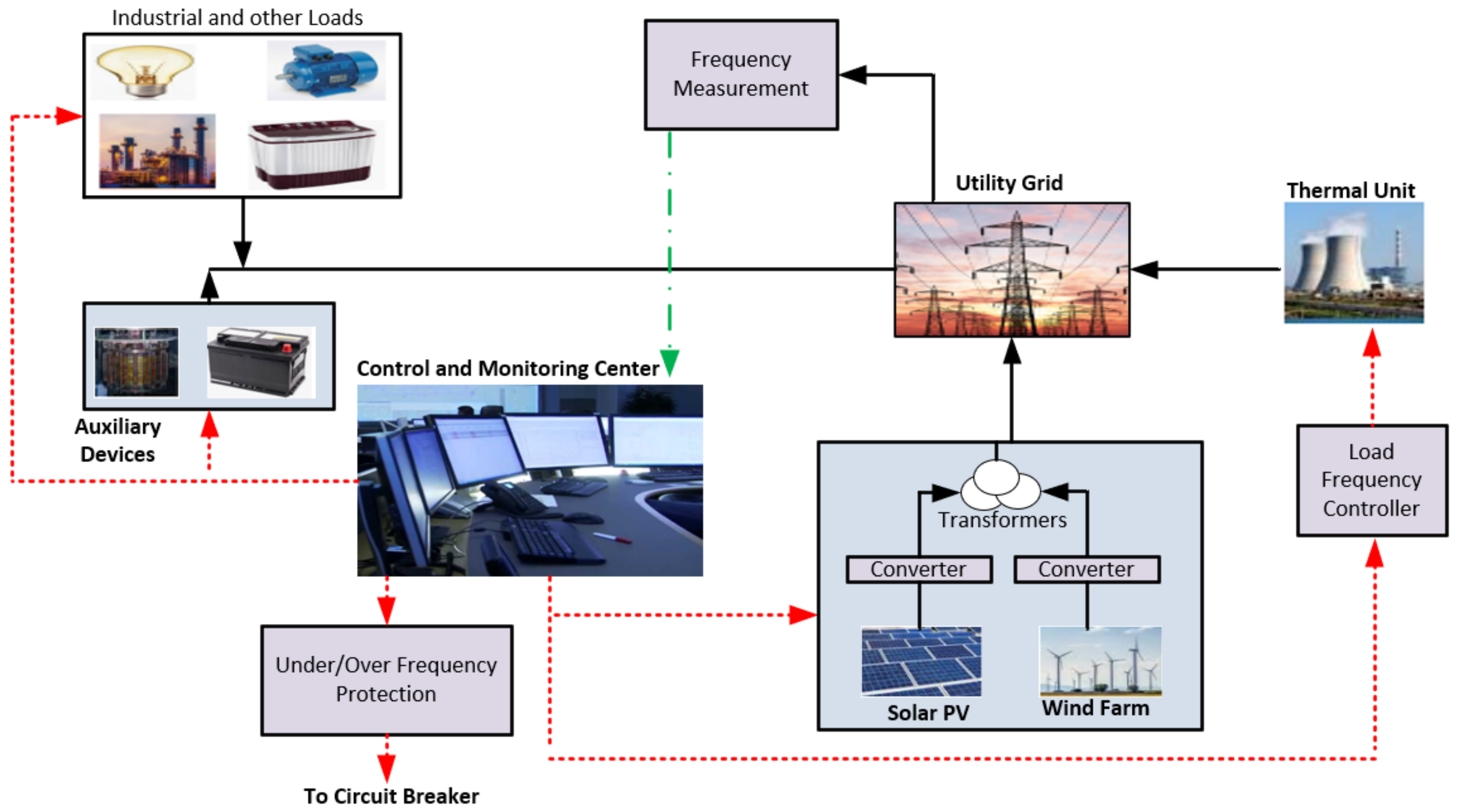
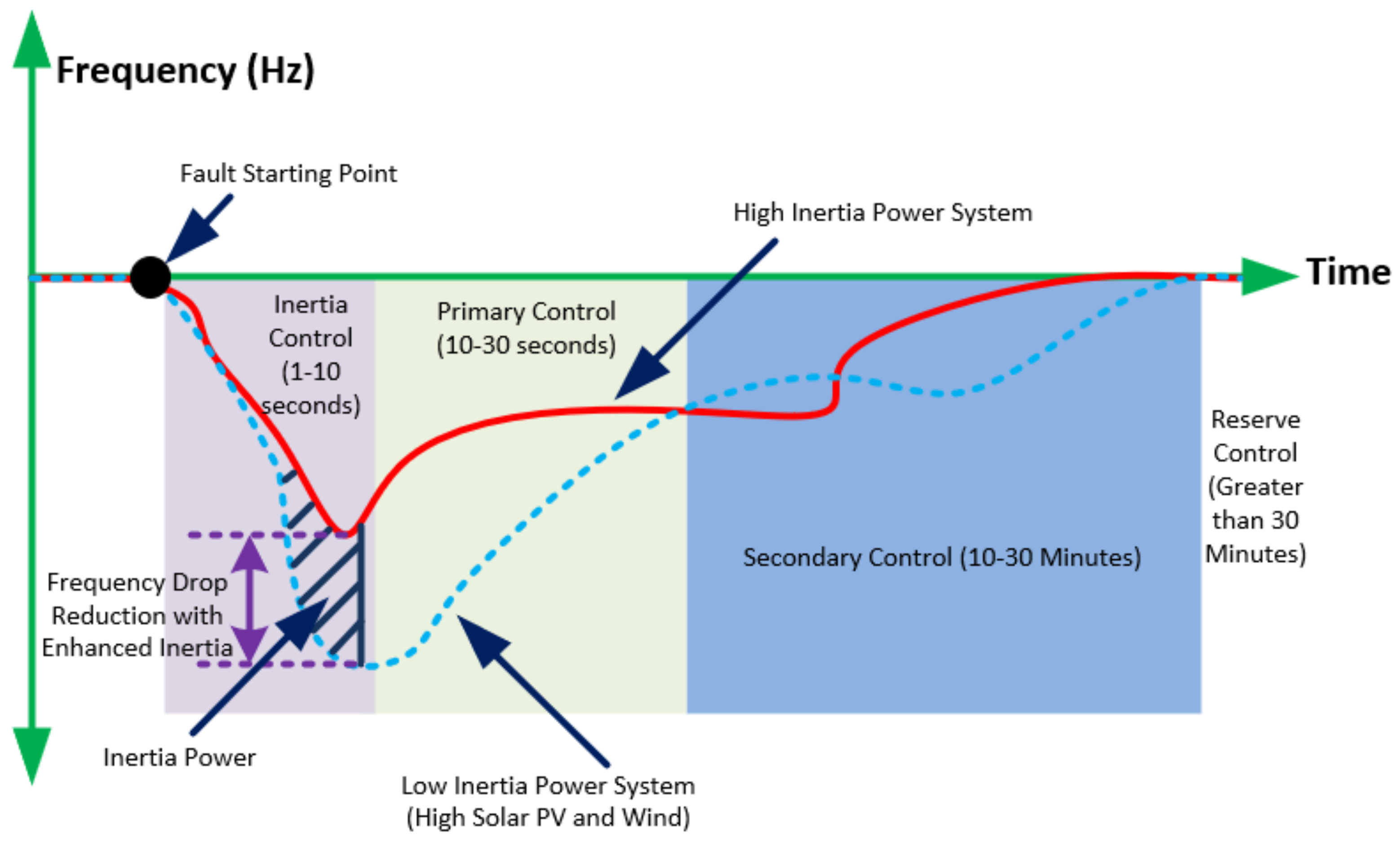
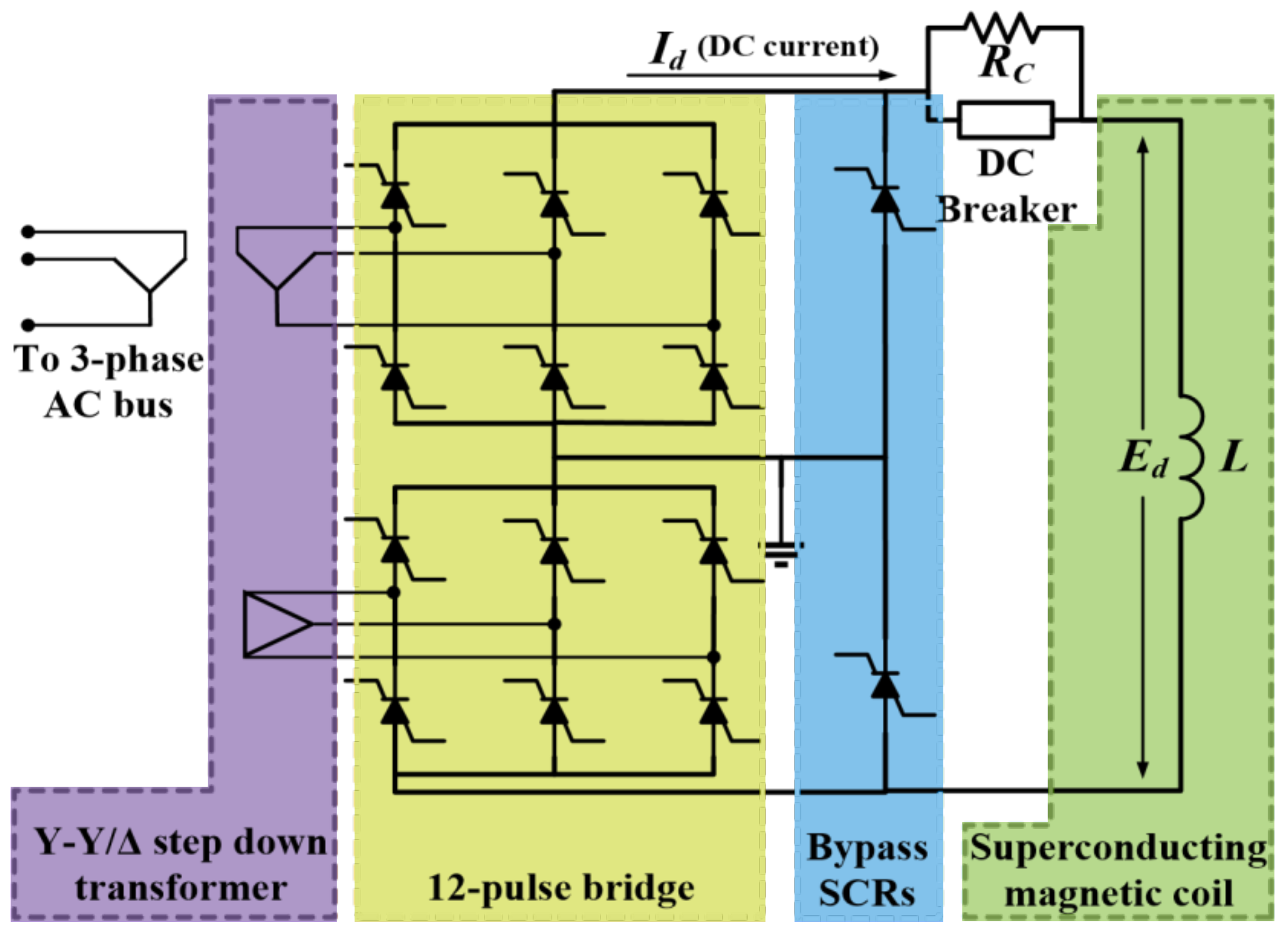

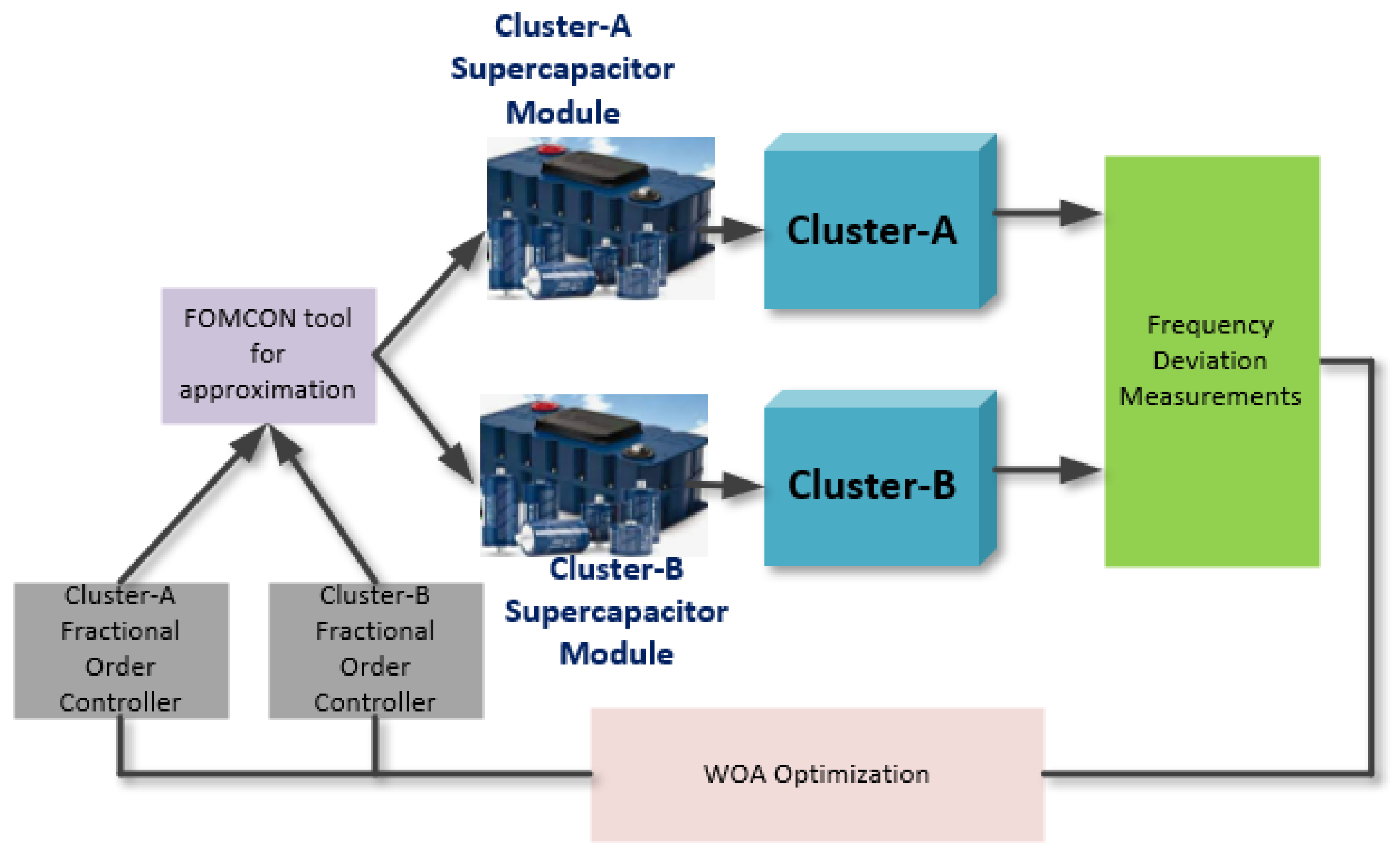

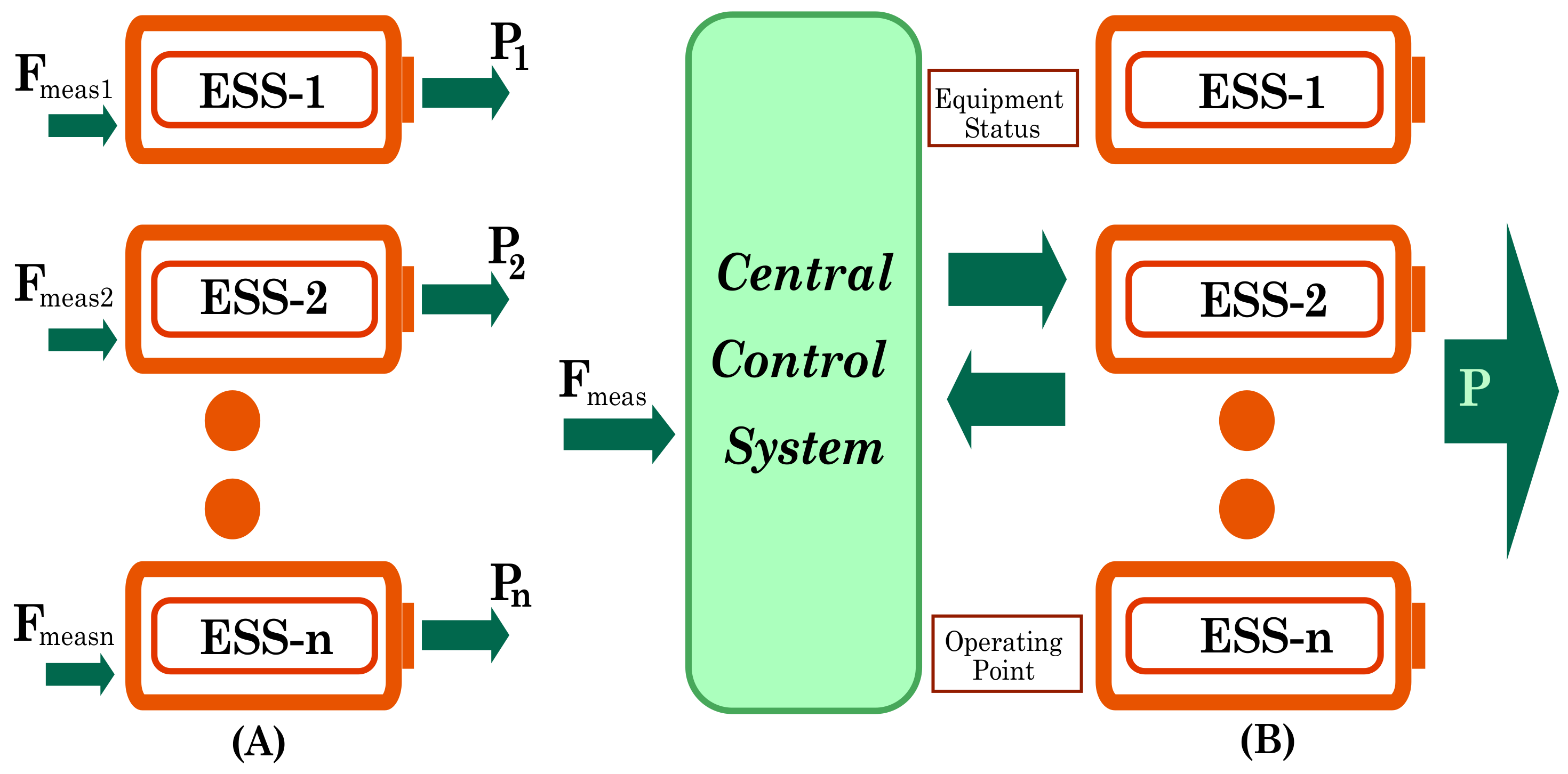

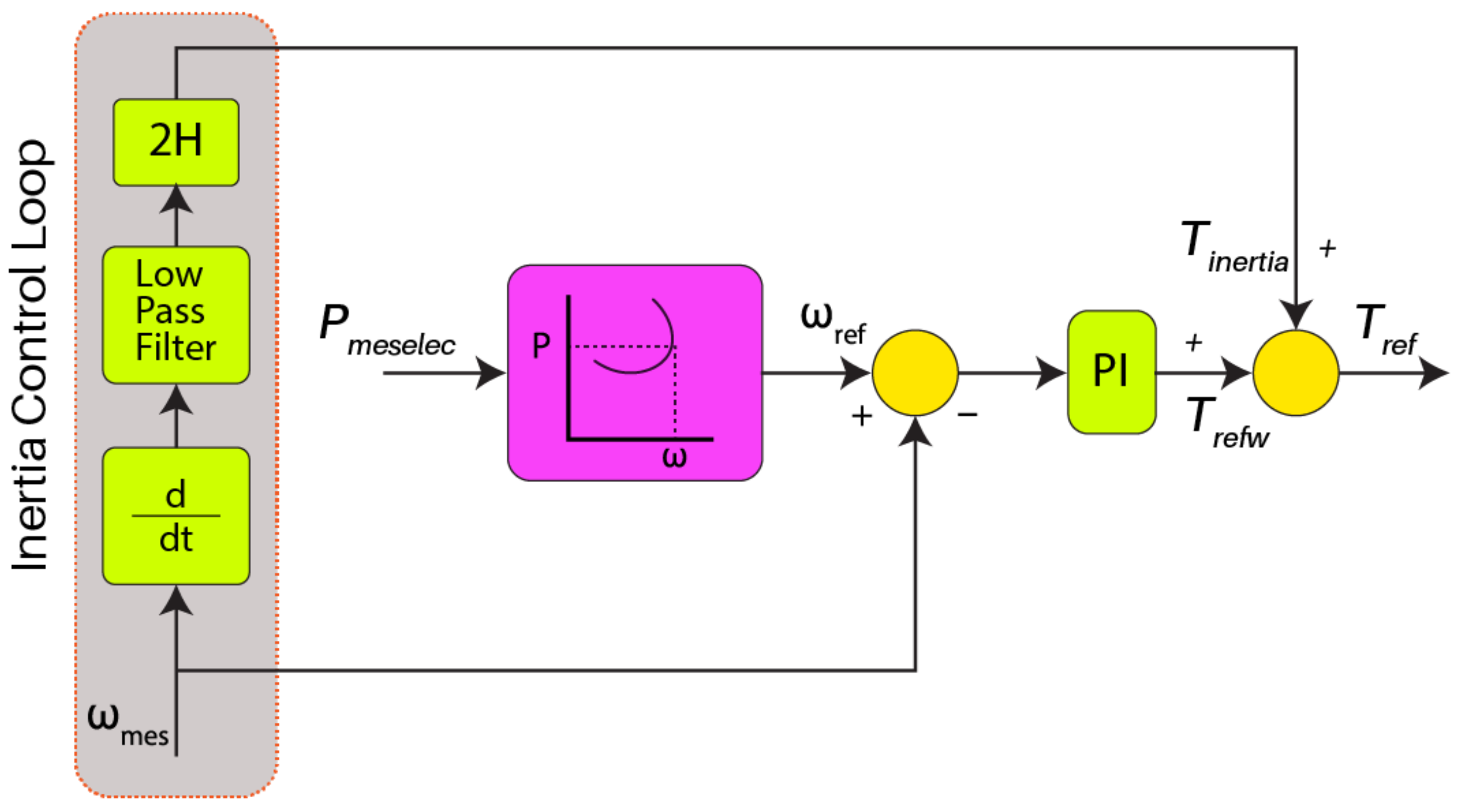
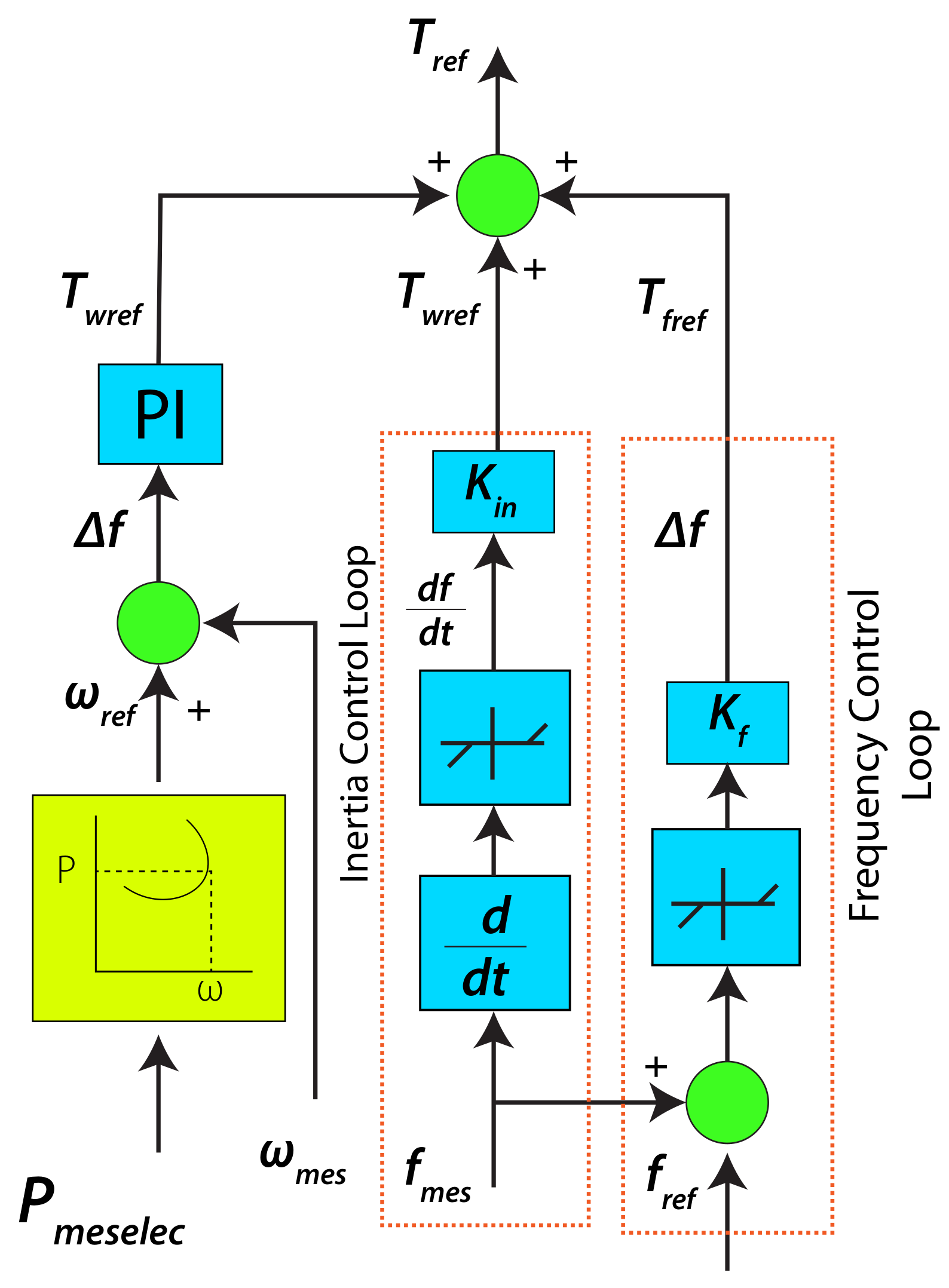
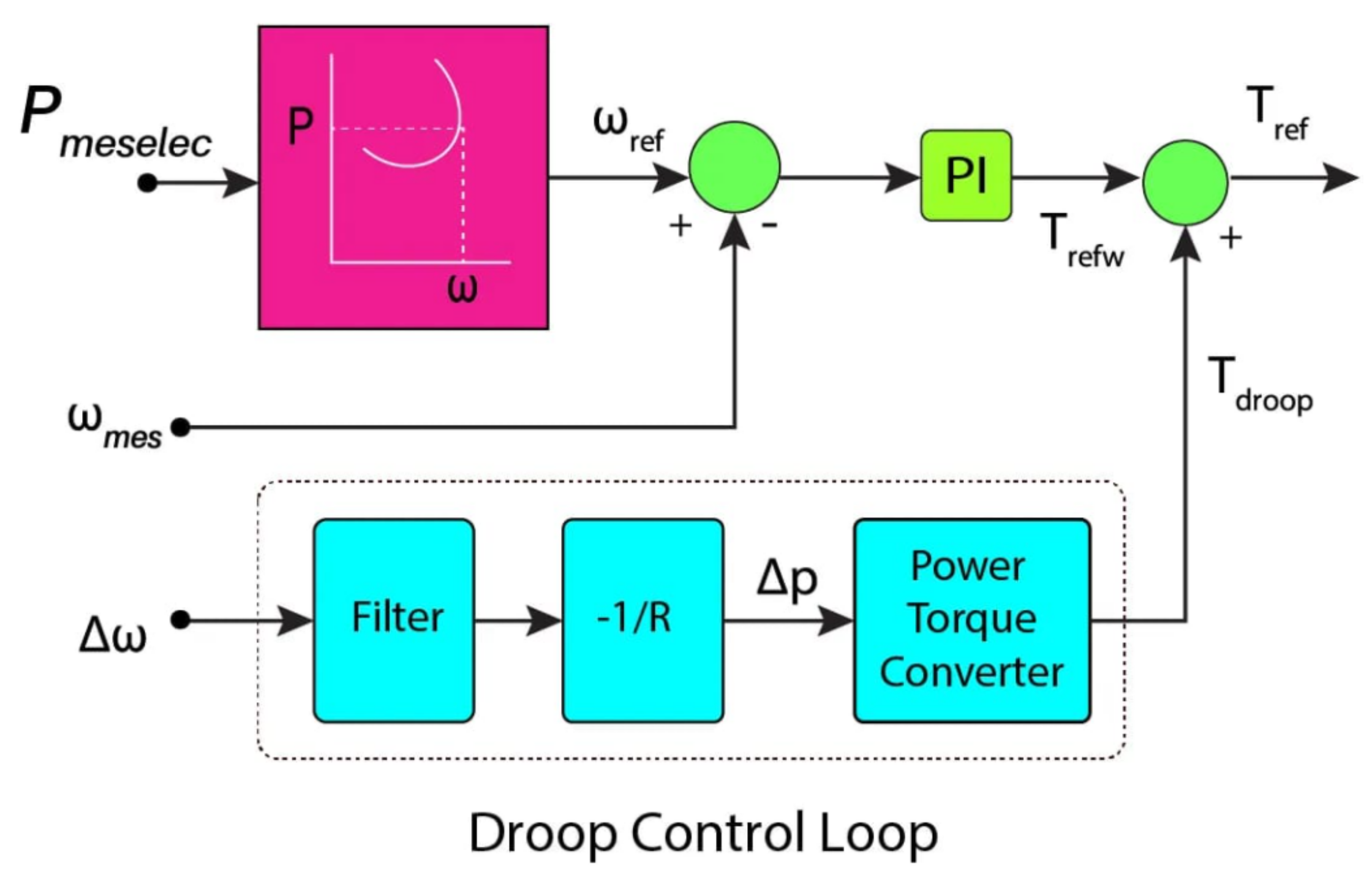
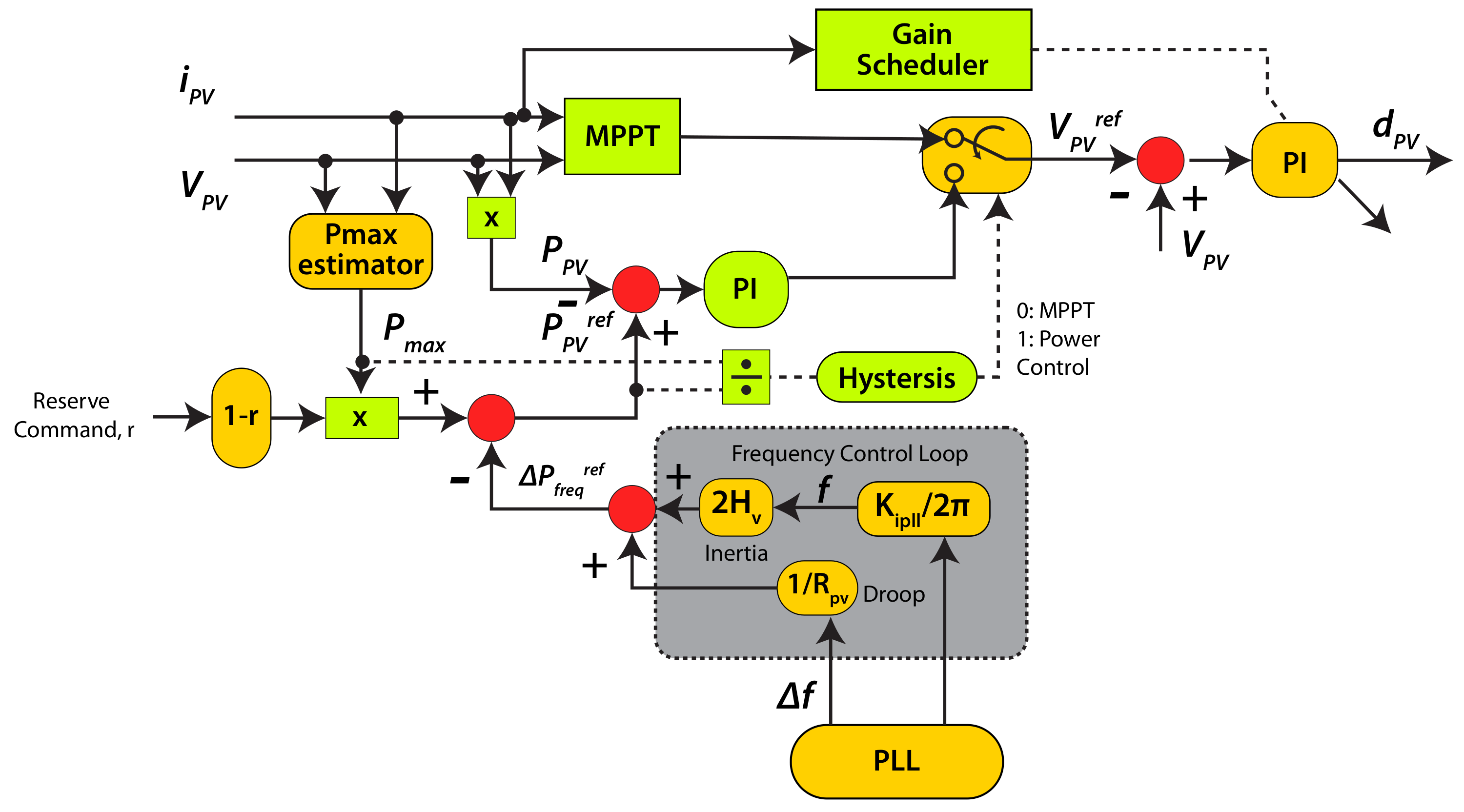
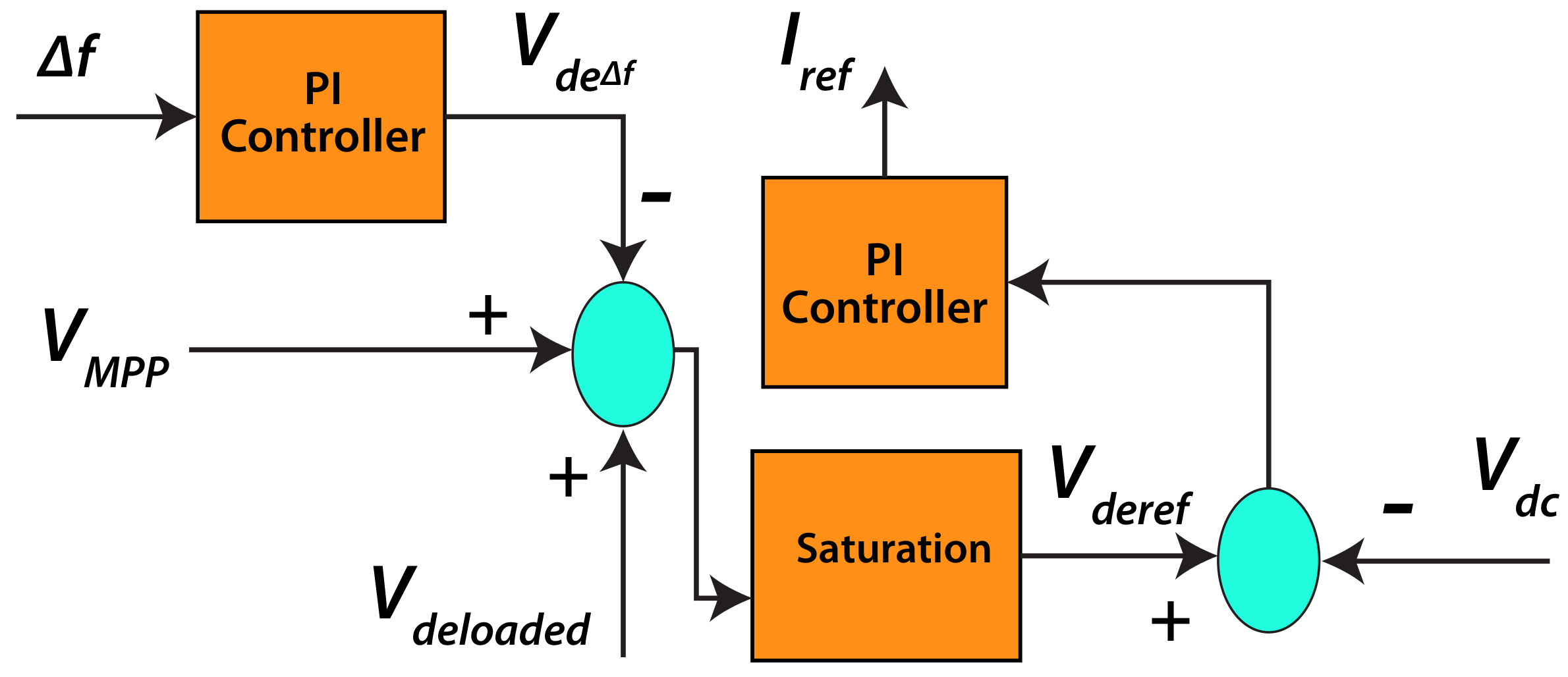

| Reference | Wind Generators | Systems | Analytical Platform | SMES Hybridization | |||||||
|---|---|---|---|---|---|---|---|---|---|---|---|
| DFIG | PMSG | SCIG | Multiple | Microgrid | Multi-Area | Utility Grid | MATLAB | Digsilent Power Factory | PSCAD | ||
| [62] | √ | √ | √ | √ | |||||||
| [65] | √ | √ | |||||||||
| [66] | √ | √ | √ | ||||||||
| [67] | √ | √ | |||||||||
| [68,69] | √ | √ | √ | √ | √ | √ | |||||
| [70] | √ | ||||||||||
| [70] | √ | √ | |||||||||
| [71,72] | √ | √ | √ | ||||||||
| Methods | Advantages | Disadvantages | References |
|---|---|---|---|
| SMES | Increasing frequency stability by lowering frequency oscillation and transient excursion as well as boosting inertia emulation capabilities | To keep the coil at low temperatures, a lot of power is needed. | [87] |
| FACTS Devices | These devices are suitable for low frequency oscillation damping | Steady-state frequency cannot be well controlled | [73,74,88,89] |
| Flywheel | Very fast response and high flexibility | It has mechanical stress and fatigue limits | [90] |
| EDFC with Storage System | i. Control is accomplished out using a precalculated or projected operating point when a disruption arises ii. EDFC does not contravene the grid-code criteria while in operation | Proper information is required to demonstrate the expected performance for a specific event | [91,92] |
| Storage Devices with RDFC | It can modify its output as per measured frequency; RDFC exploits the local measured frequency, which has the major benefit of eliminating the need for communication. | Due to the nonlinearity of the system frequency characteristics, it is hard to procure reliable information | [91,93] |
| BSS | i. Battery storage is utilized to provide inertia and primary frequency regulation ii. A battery storage system can be used to control the grid frequency when wind power plants are widely deployed iii. During the microgrid’s primary frequency control level, the battery is utilized to regulate active power transfer | Batteries’ lifespan will be diminished if significant power peaks are handled. When a power imbalance occurs suddenly and repeatedly, the battery will experience continual charging and discharging activities. It puts more stress on the battery and shortens its life. | [94,95] |
| Supercapacitor | For high-frequency power variations, a a supercapacitor can be implemented easily ii. By absorbing power in frequency deviations, a supercapacitor can react faster to offset the frequency deviation than other auxiliary devices | i. Even though using SC, another storage system is required to restore the frequency to its nominal value ii. High power density SC is required for improved performance which raising the cost level | [95] |
| Methods | Advantages | Disadvantages | References |
|---|---|---|---|
| De-loading | i. This technique can be observed as a way to offer more active power in situations where it is needed. ii. It maintains the frequency by providing reserve power | The quantity of backup power varies sometimes. The majority of de-loading approaches entail operating a wind turbines in the de-loaded mode for an extended period of time, which results in financial losses. | [164] |
| Inertial Response | i. Through the use of RESs, the inertial response technique simulates the behavior of conventional synchronous generators. ii. It has more virtual inertia, which helps to slow the rate of change of frequency. | i. The fundamental disadvantage of this system is that the amount of torque delivered by the second control loop is fixed, resulting in quick rotor speed reduction and controller operation delay. ii. It has a negative impact on the system’s stability. | [207] |
| Neural Network | i. By controlling the speed of the turbine blade with the help of pitch angle management, neural networks can regulate the power output and system frequency ii. When there is a major change in the system, a neural-based controller can quickly restore the frequency to its nominal value. | i. A substation is required in a neural system to maintain software and hardware control. ii. The planning and construction of a neural network is complex. | [208] |
| Particle Swarm | i. It has the ability in tuning the parameters of the controllers for intelligent frequency control in an AC microgrid. ii. It can also help AGC in multi-source nonlinear power systems with AC/DC connections. | i. It has some drawbacks in real-time economic dispatch applications and a limited mathematical foundation for analysis. ii. It can occasionally fall into a local optimum in a high-dimensional space | [209,210] |
| Genetic Algorithm | For interconnected power networks, it can be utilized as a load frequency controller and allows for multi-objective load frequency control | It cannot be used for online LFC parameters tuning | [211] |
| Tabu Search | PI parameters designed by Tabu Search for LFC provide stable operation over wide range of uncertainty | In LFC designing process, it may fall to local optimum | [212,213,214] |
Disclaimer/Publisher’s Note: The statements, opinions and data contained in all publications are solely those of the individual author(s) and contributor(s) and not of MDPI and/or the editor(s). MDPI and/or the editor(s) disclaim responsibility for any injury to people or property resulting from any ideas, methods, instructions or products referred to in the content. |
© 2023 by the authors. Licensee MDPI, Basel, Switzerland. This article is an open access article distributed under the terms and conditions of the Creative Commons Attribution (CC BY) license (https://creativecommons.org/licenses/by/4.0/).
Share and Cite
Alam, M.S.; Chowdhury, T.A.; Dhar, A.; Al-Ismail, F.S.; Choudhury, M.S.H.; Shafiullah, M.; Hossain, M.I.; Hossain, M.A.; Ullah, A.; Rahman, S.M. Solar and Wind Energy Integrated System Frequency Control: A Critical Review on Recent Developments. Energies 2023, 16, 812. https://doi.org/10.3390/en16020812
Alam MS, Chowdhury TA, Dhar A, Al-Ismail FS, Choudhury MSH, Shafiullah M, Hossain MI, Hossain MA, Ullah A, Rahman SM. Solar and Wind Energy Integrated System Frequency Control: A Critical Review on Recent Developments. Energies. 2023; 16(2):812. https://doi.org/10.3390/en16020812
Chicago/Turabian StyleAlam, Md. Shafiul, Tanzi Ahmed Chowdhury, Abhishak Dhar, Fahad Saleh Al-Ismail, M. S. H. Choudhury, Md Shafiullah, Md. Ismail Hossain, Md. Alamgir Hossain, Aasim Ullah, and Syed Masiur Rahman. 2023. "Solar and Wind Energy Integrated System Frequency Control: A Critical Review on Recent Developments" Energies 16, no. 2: 812. https://doi.org/10.3390/en16020812
APA StyleAlam, M. S., Chowdhury, T. A., Dhar, A., Al-Ismail, F. S., Choudhury, M. S. H., Shafiullah, M., Hossain, M. I., Hossain, M. A., Ullah, A., & Rahman, S. M. (2023). Solar and Wind Energy Integrated System Frequency Control: A Critical Review on Recent Developments. Energies, 16(2), 812. https://doi.org/10.3390/en16020812











